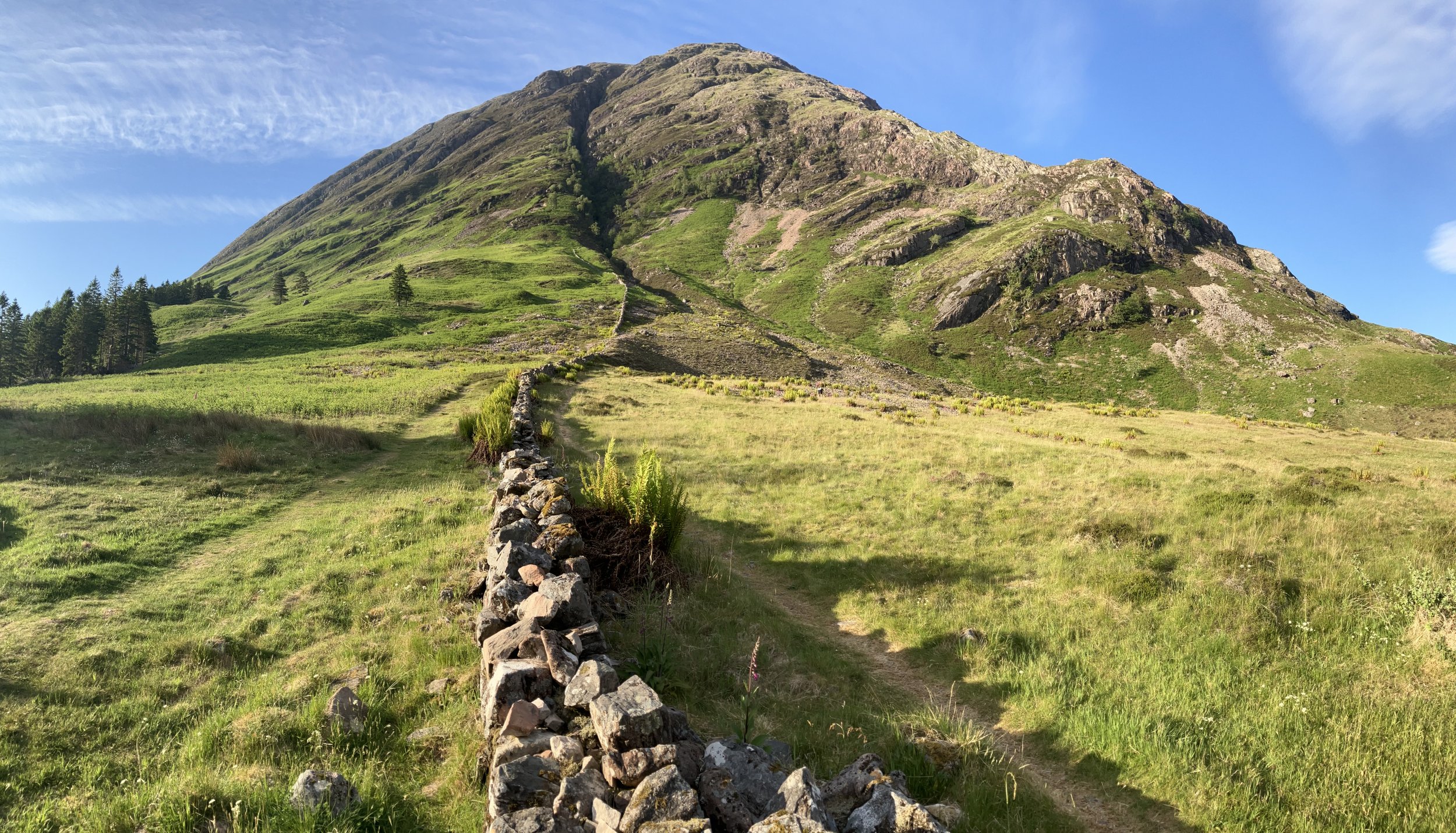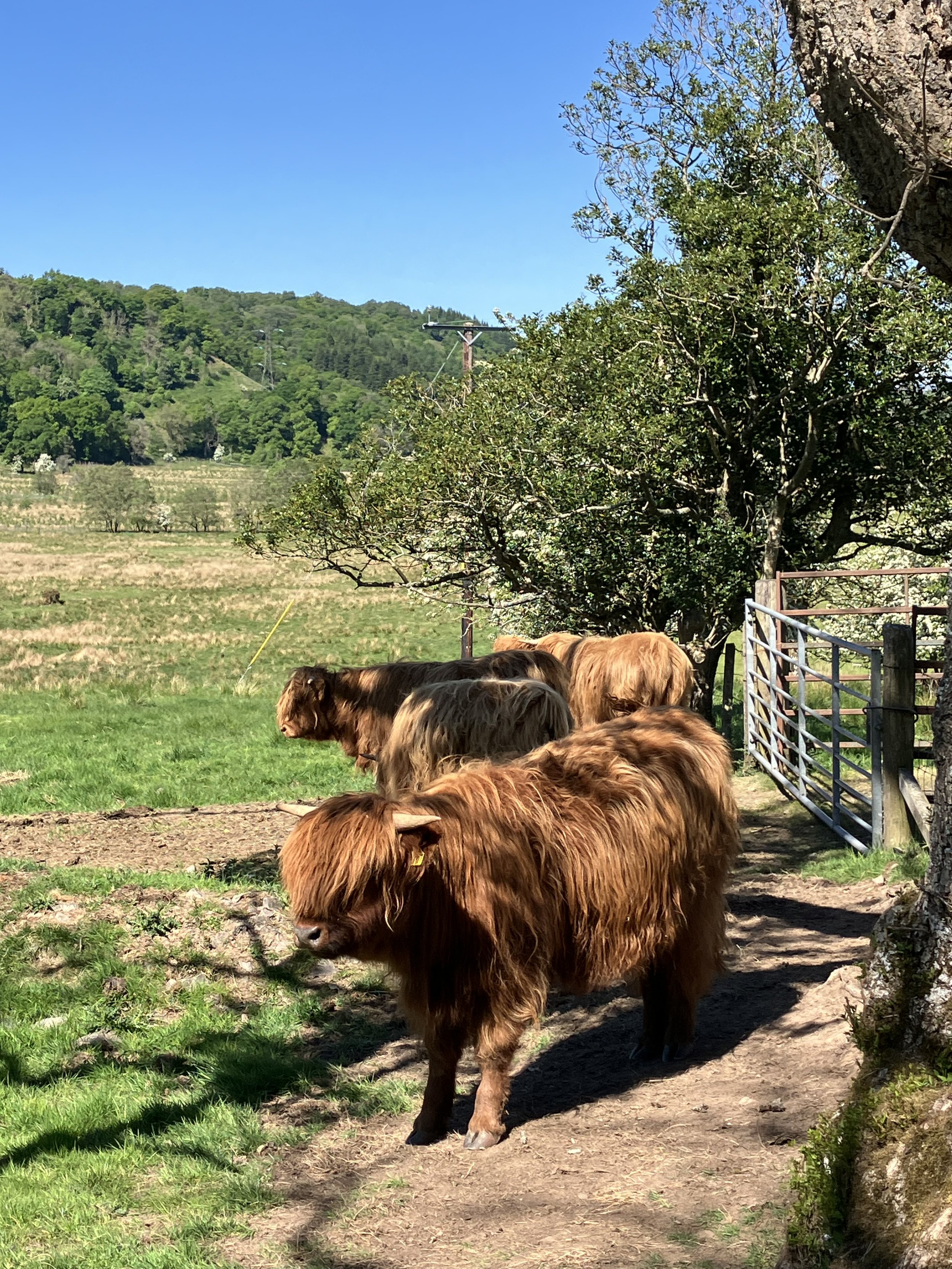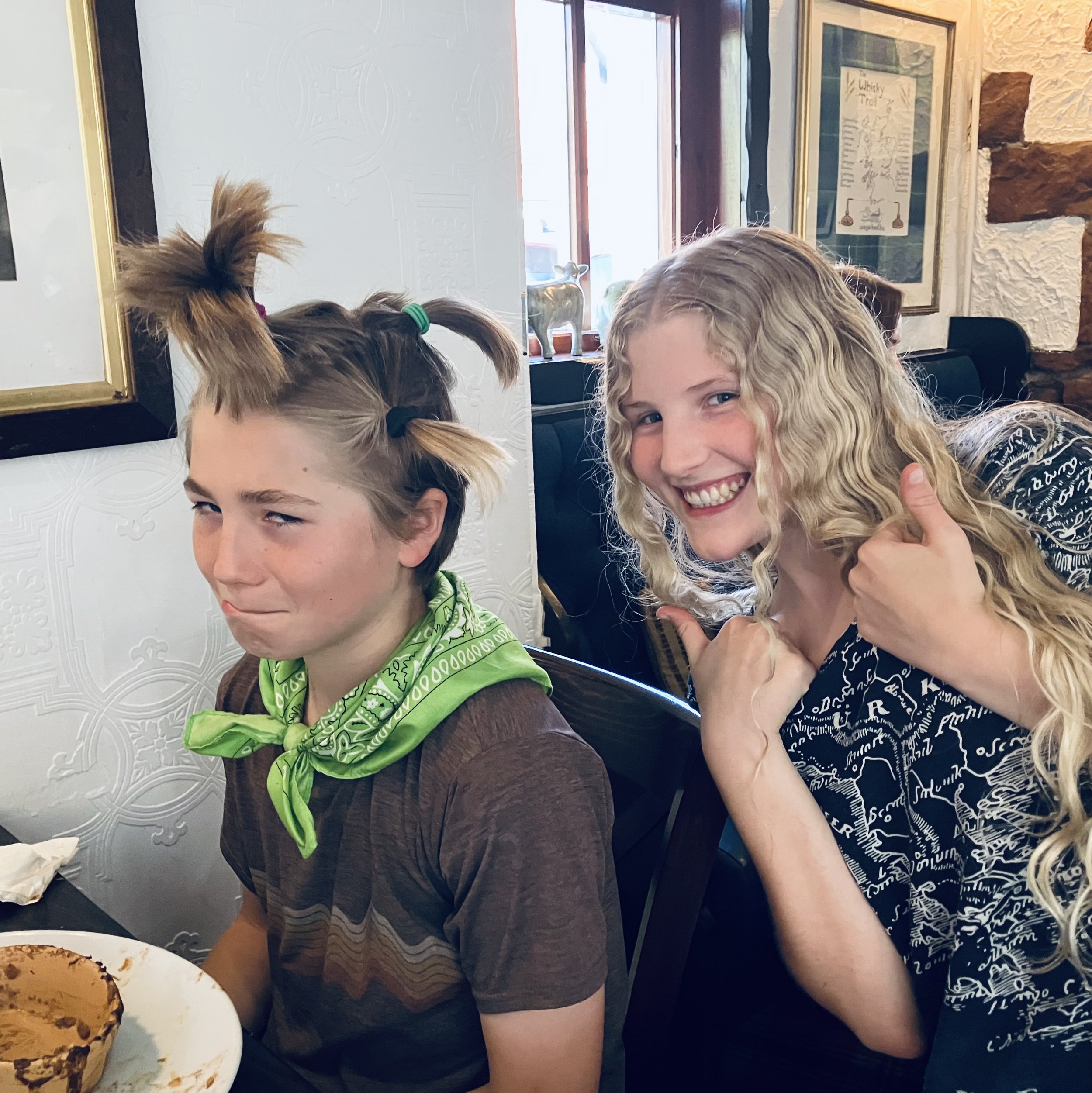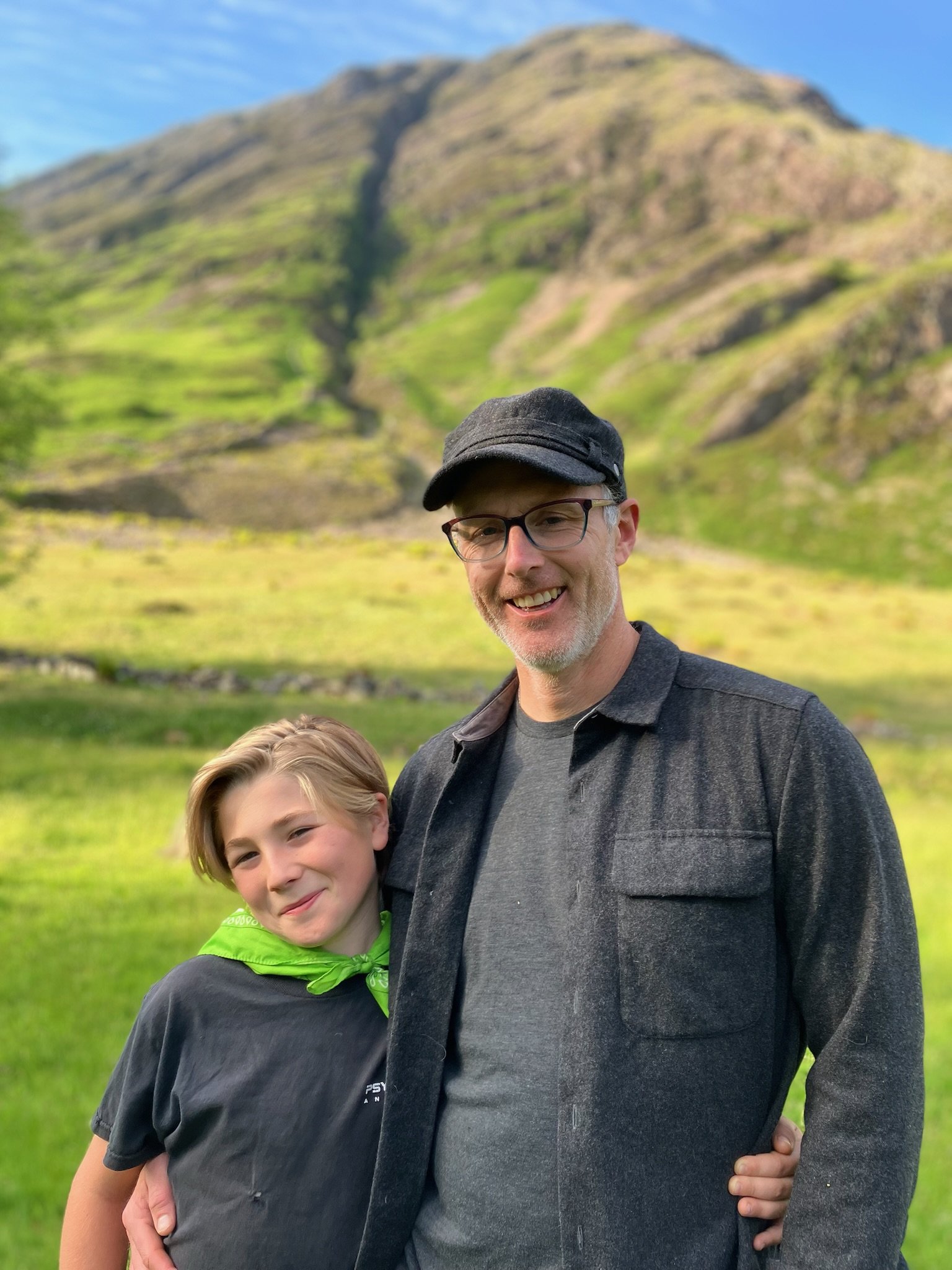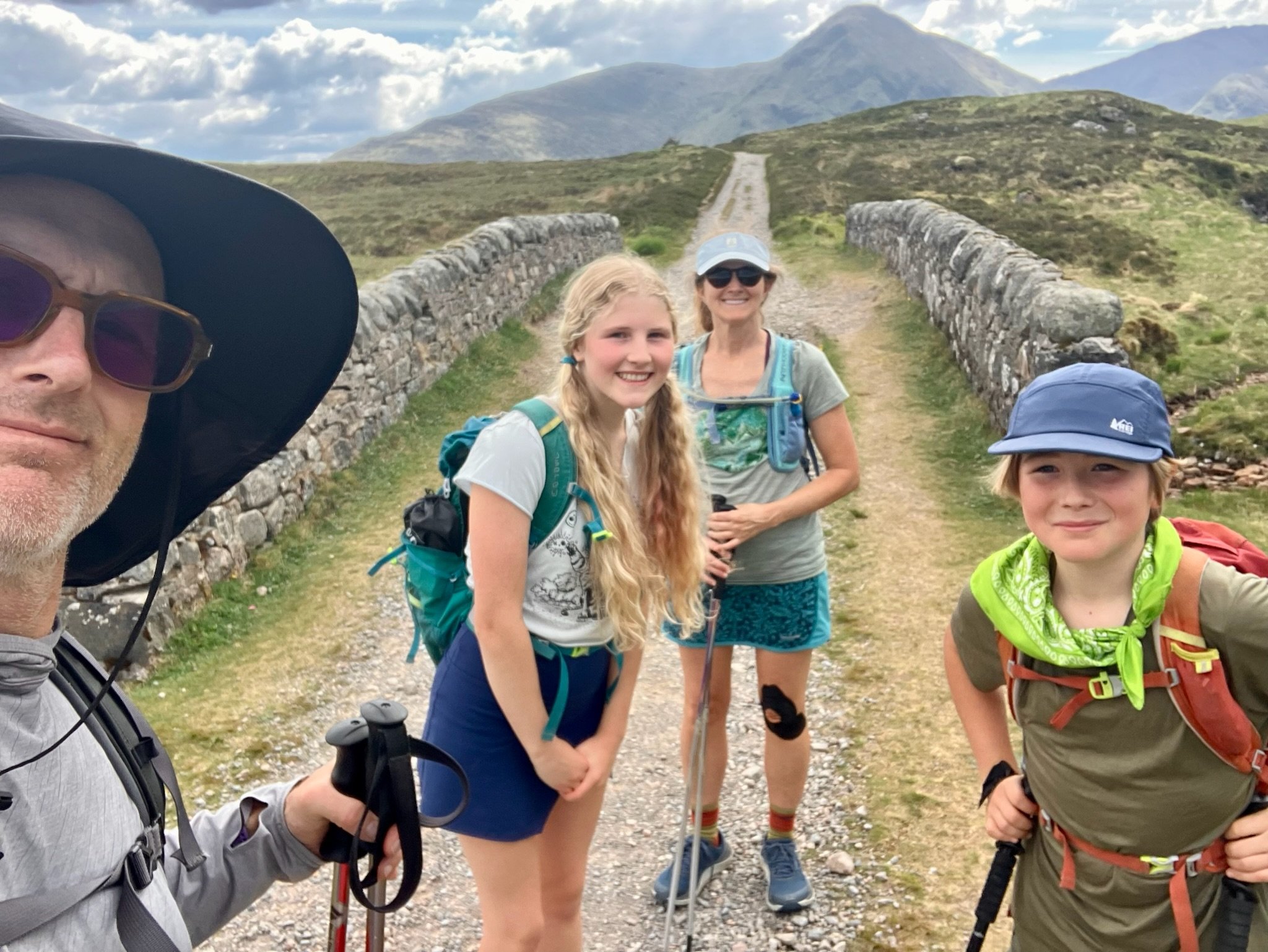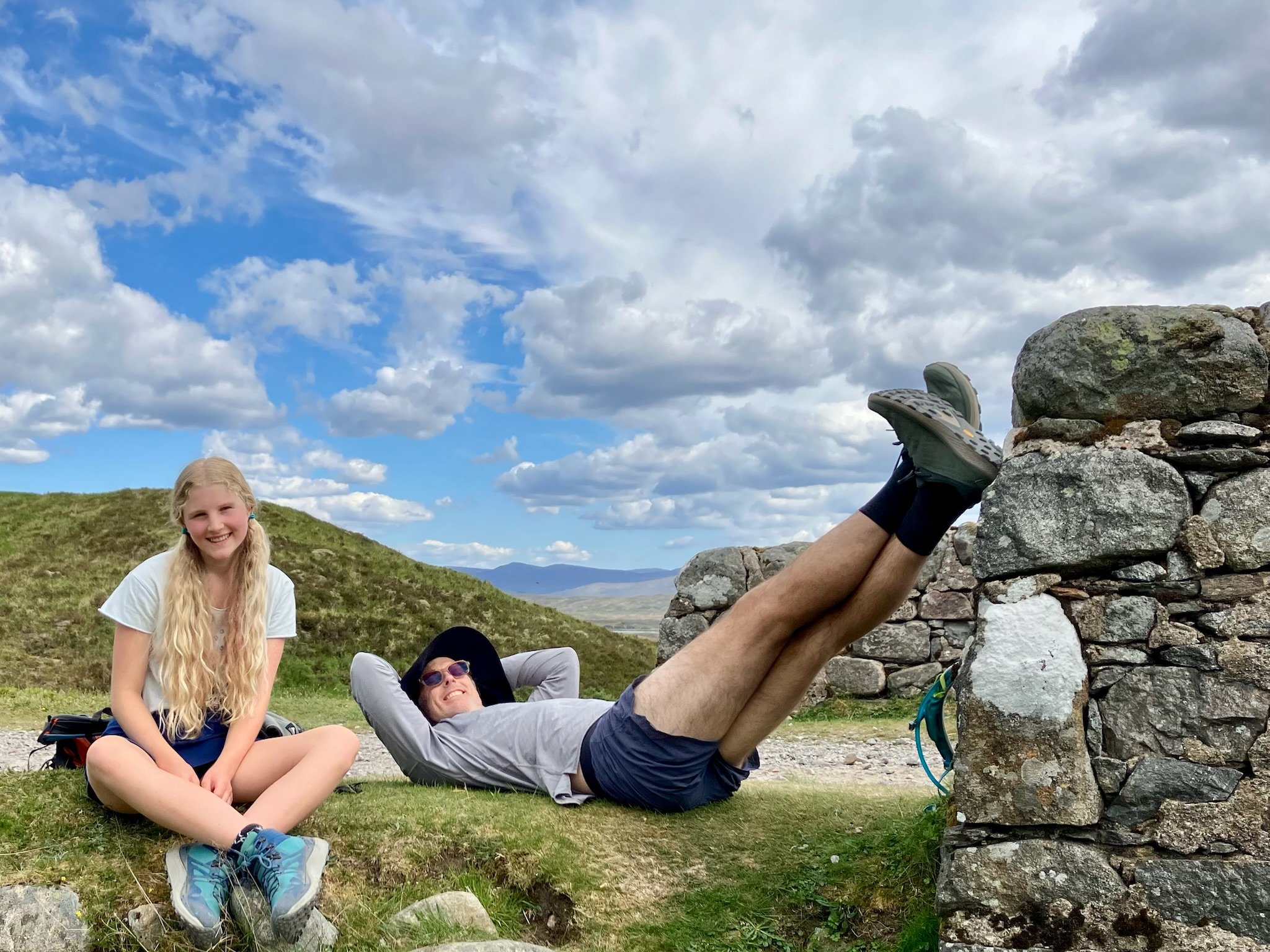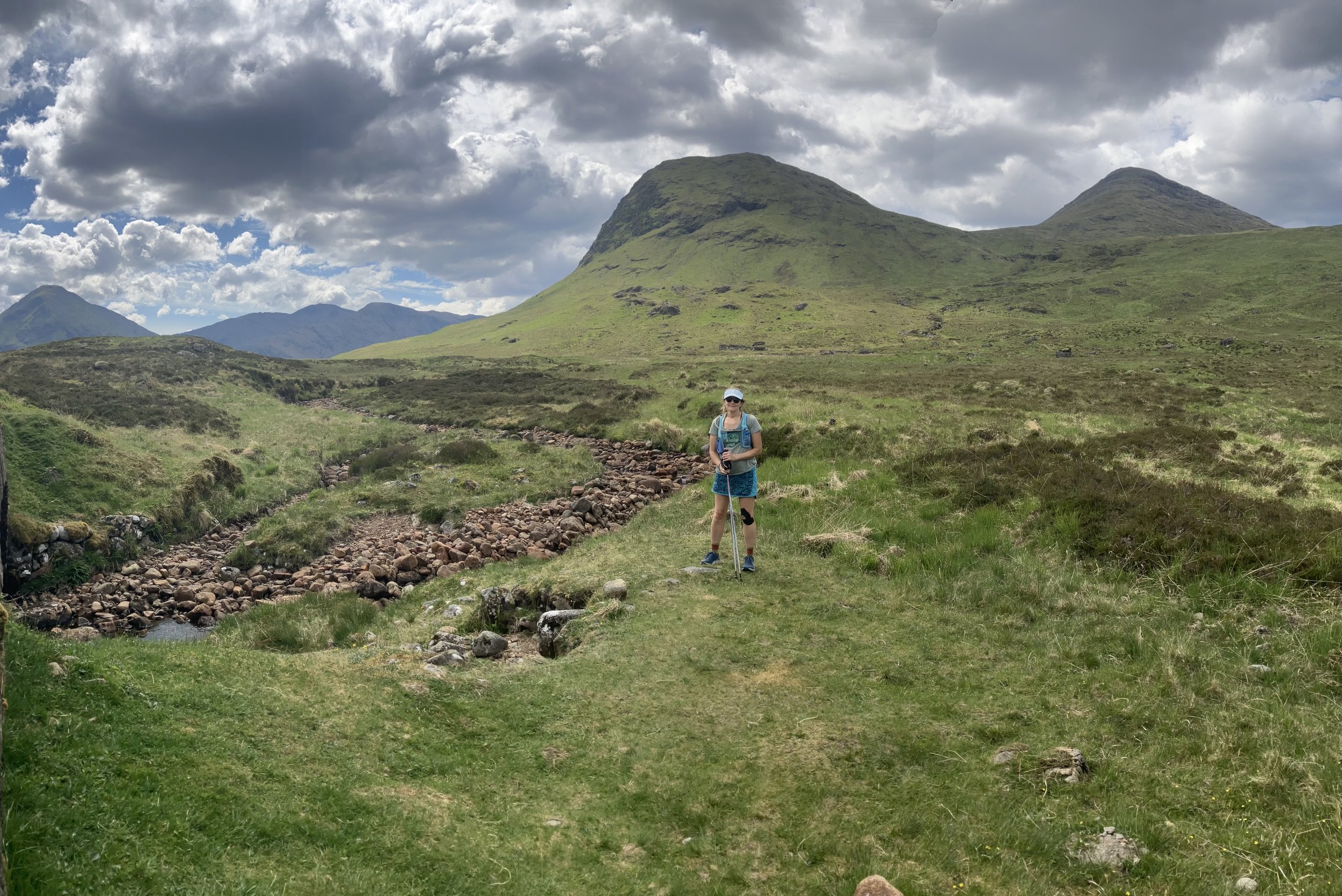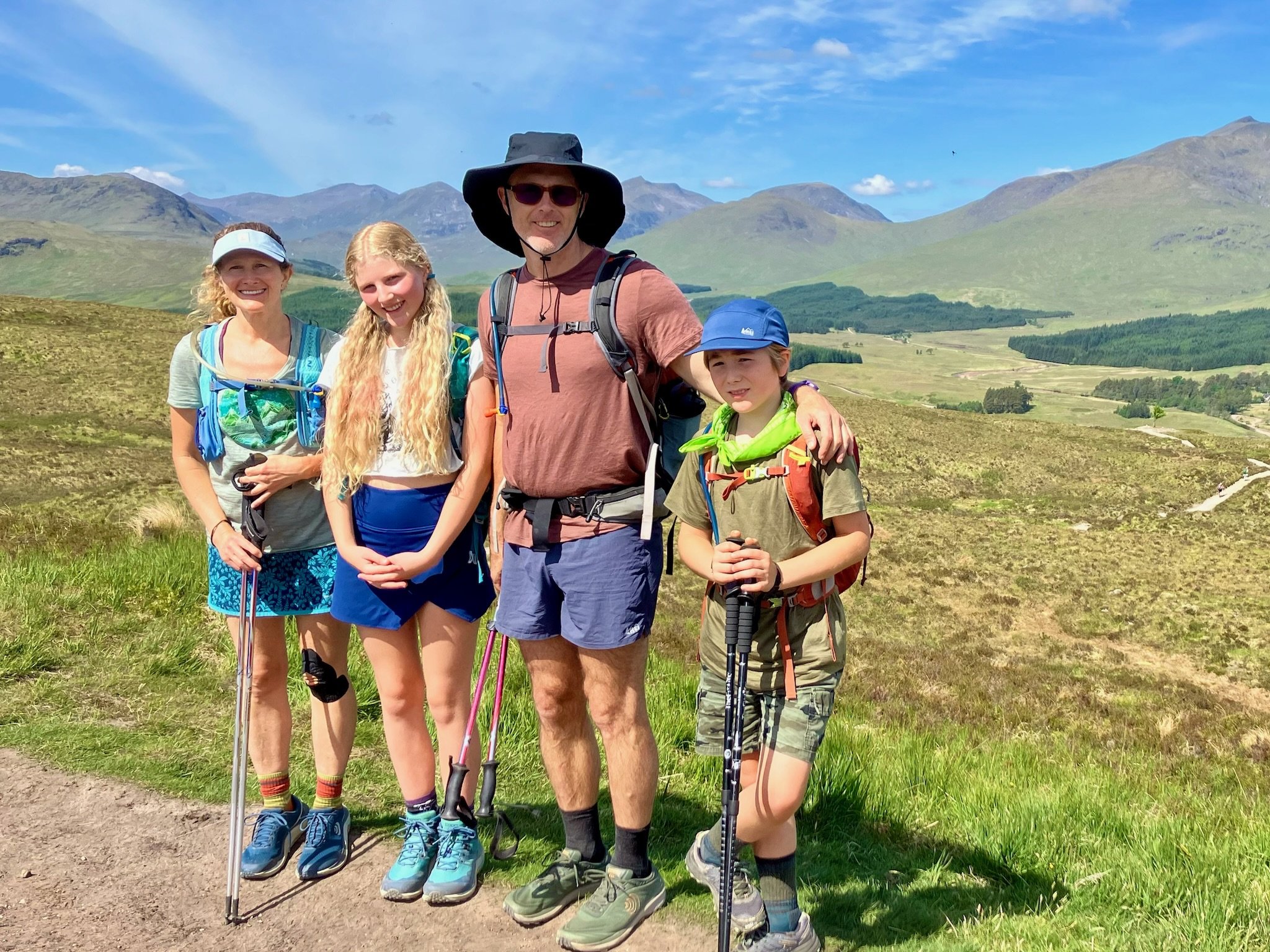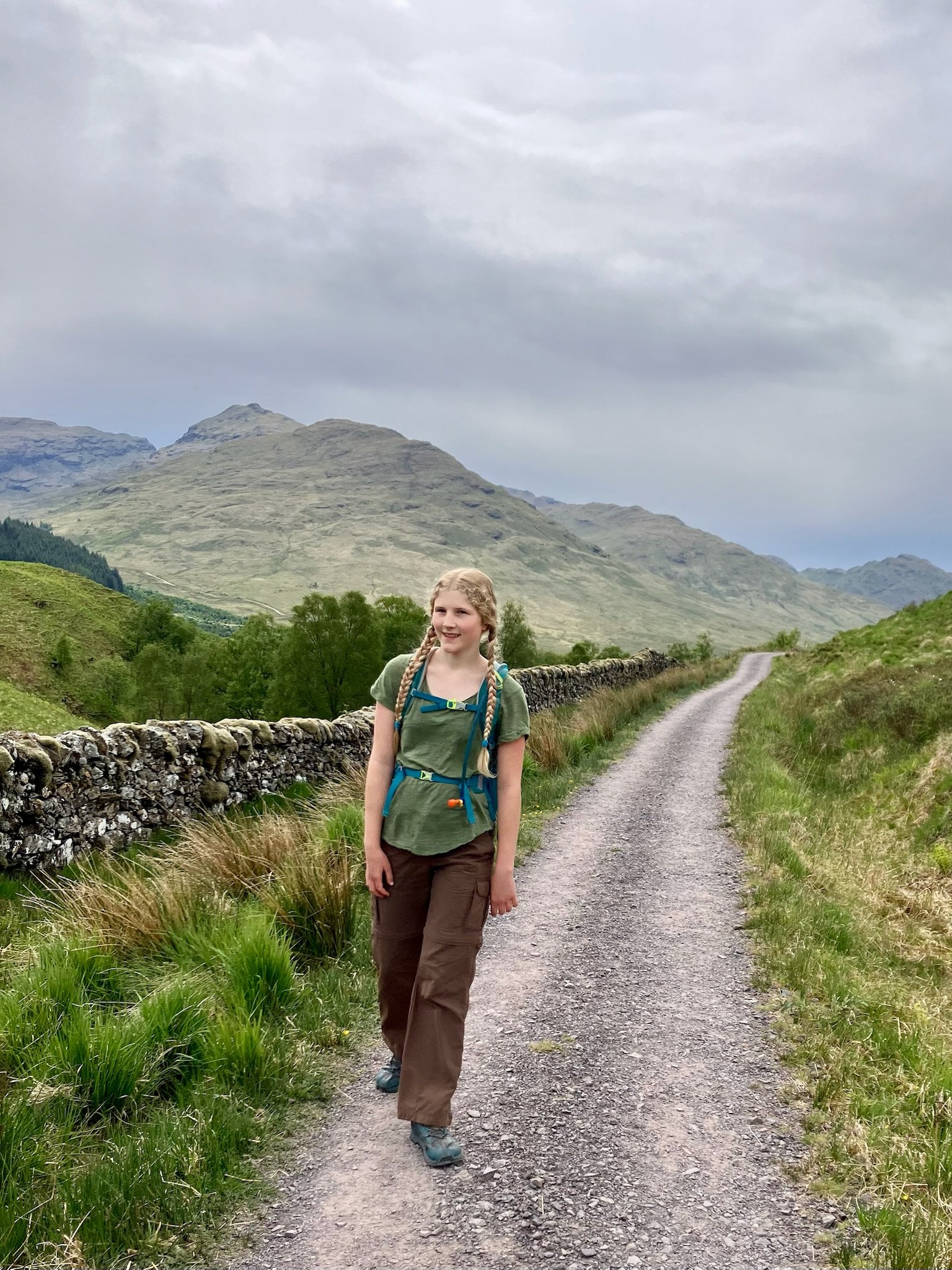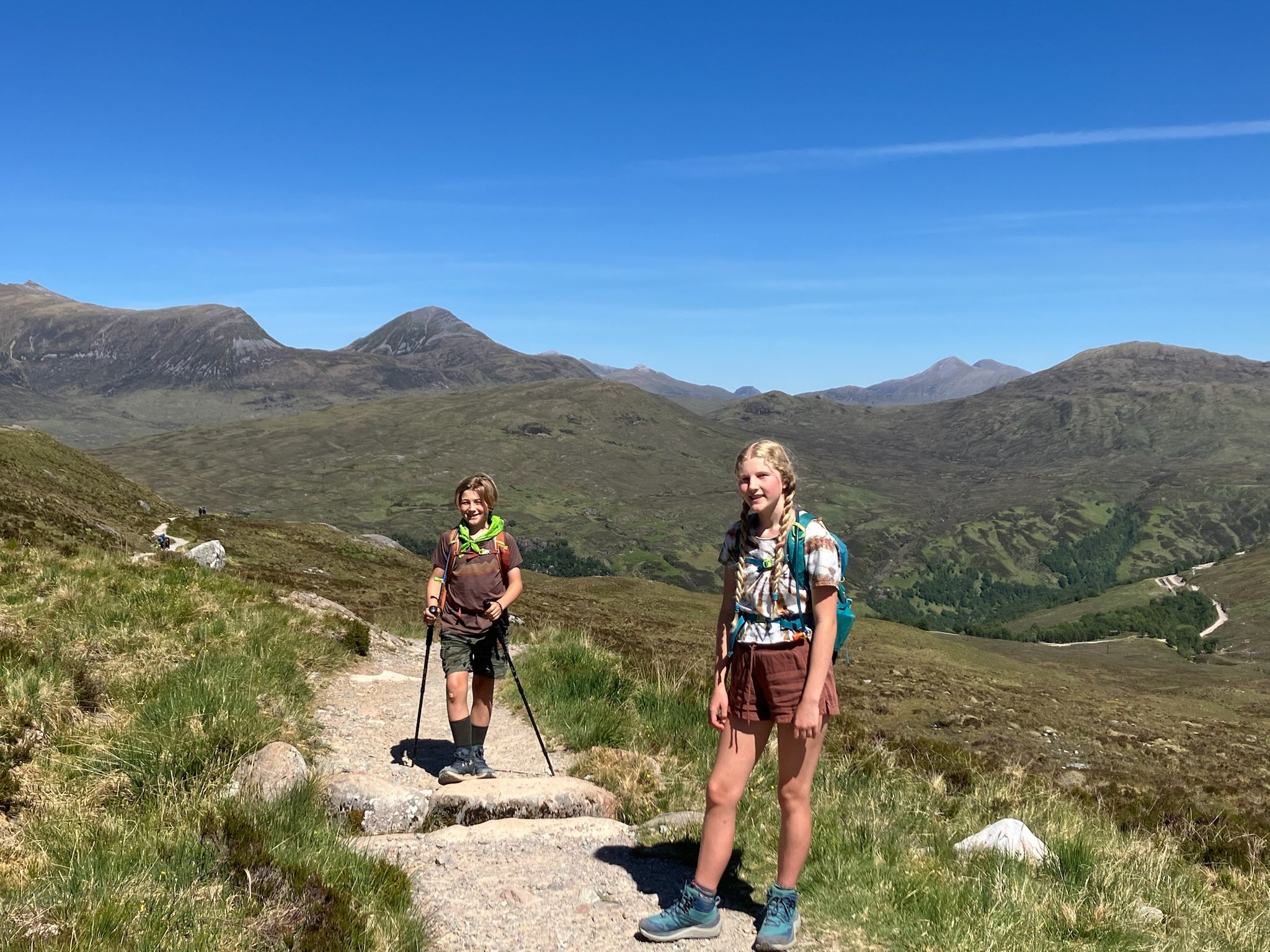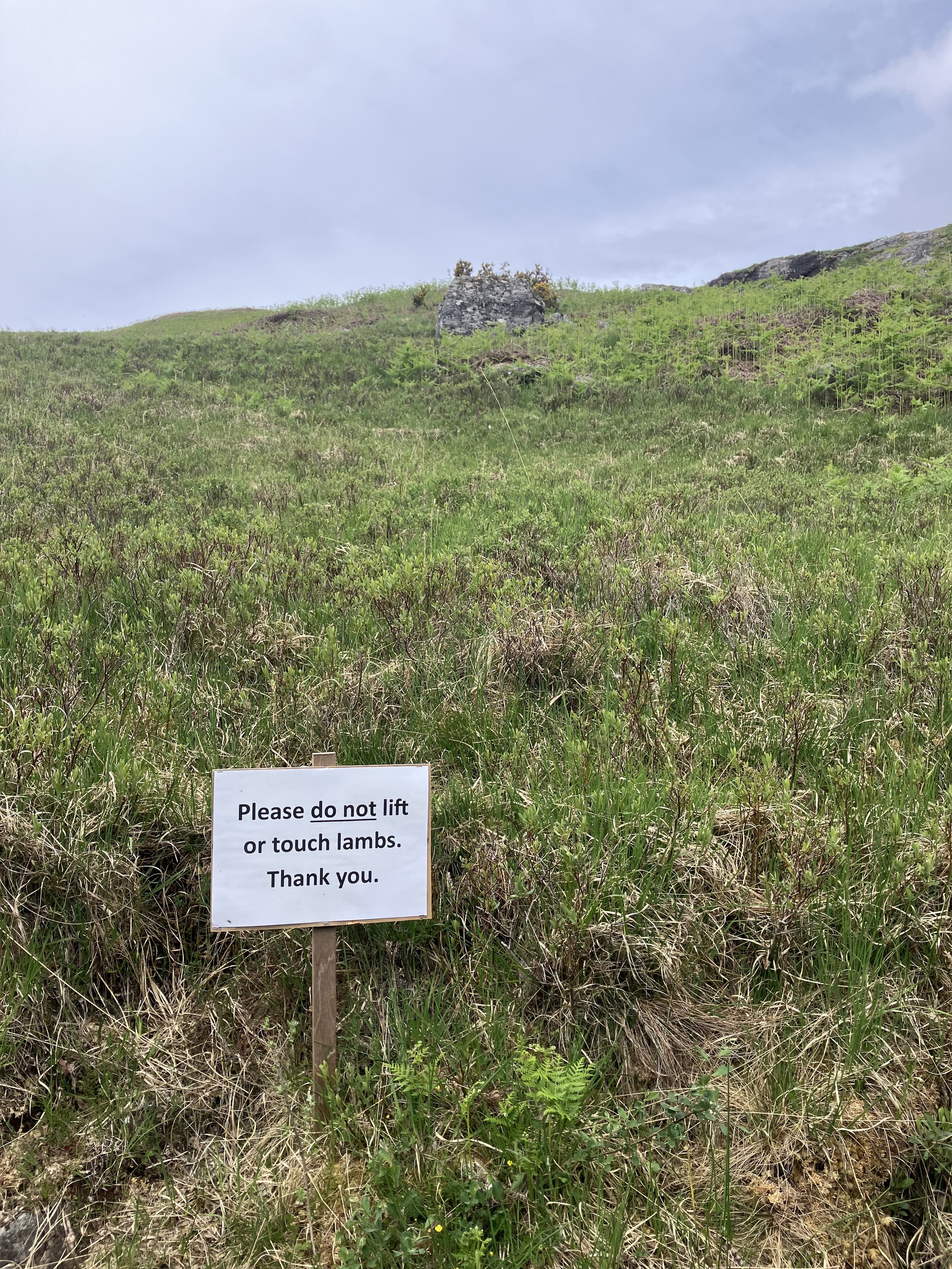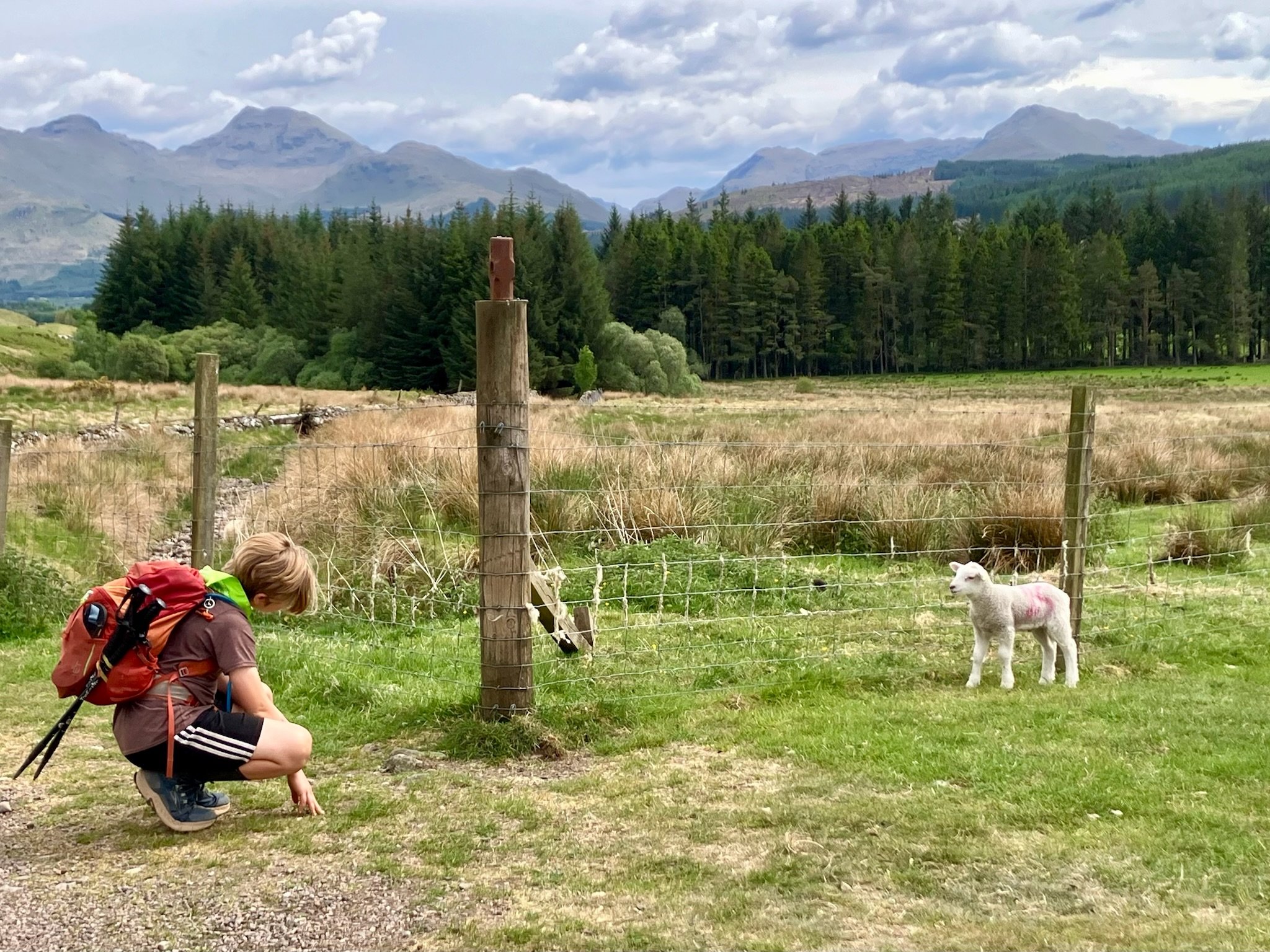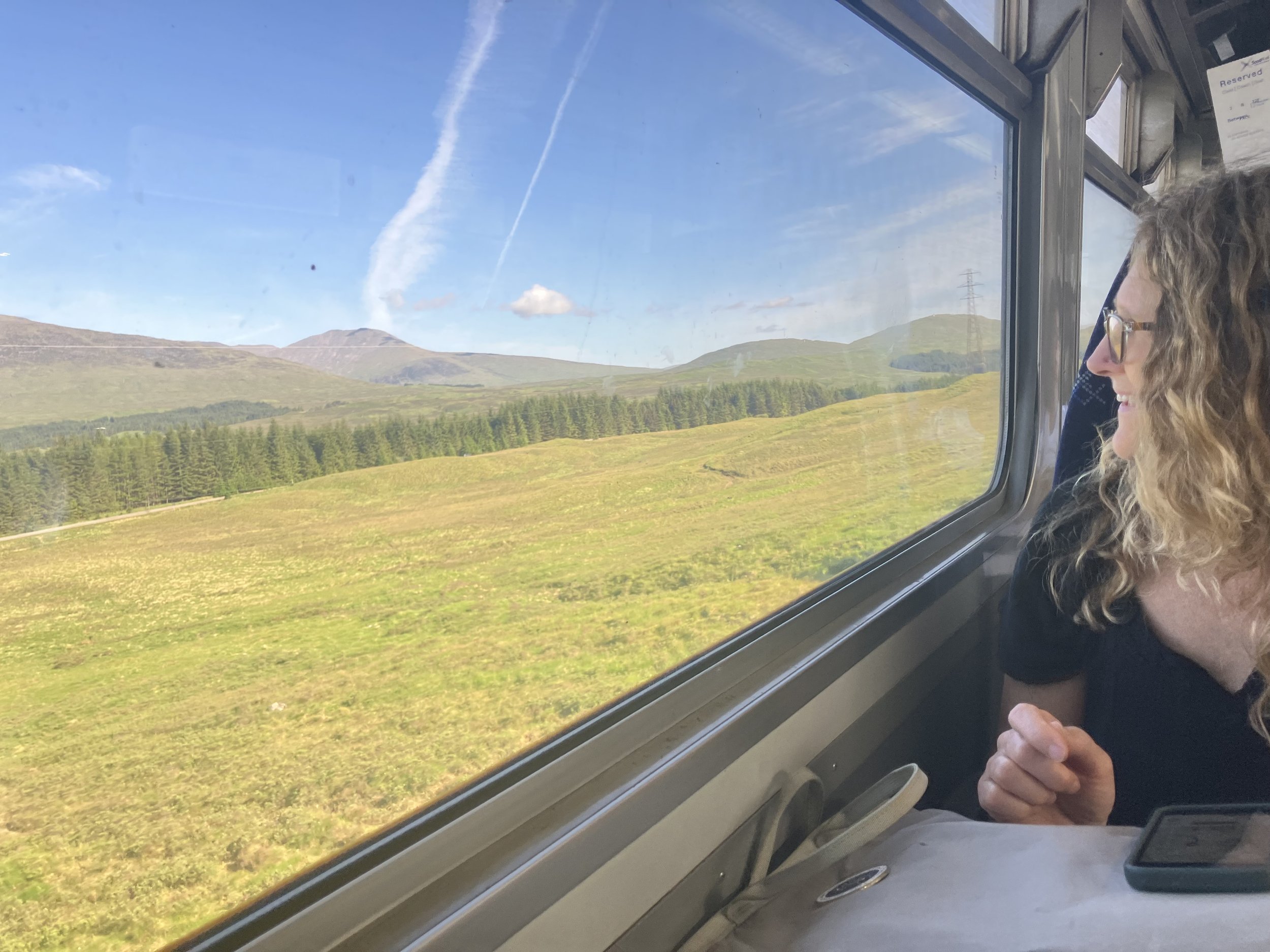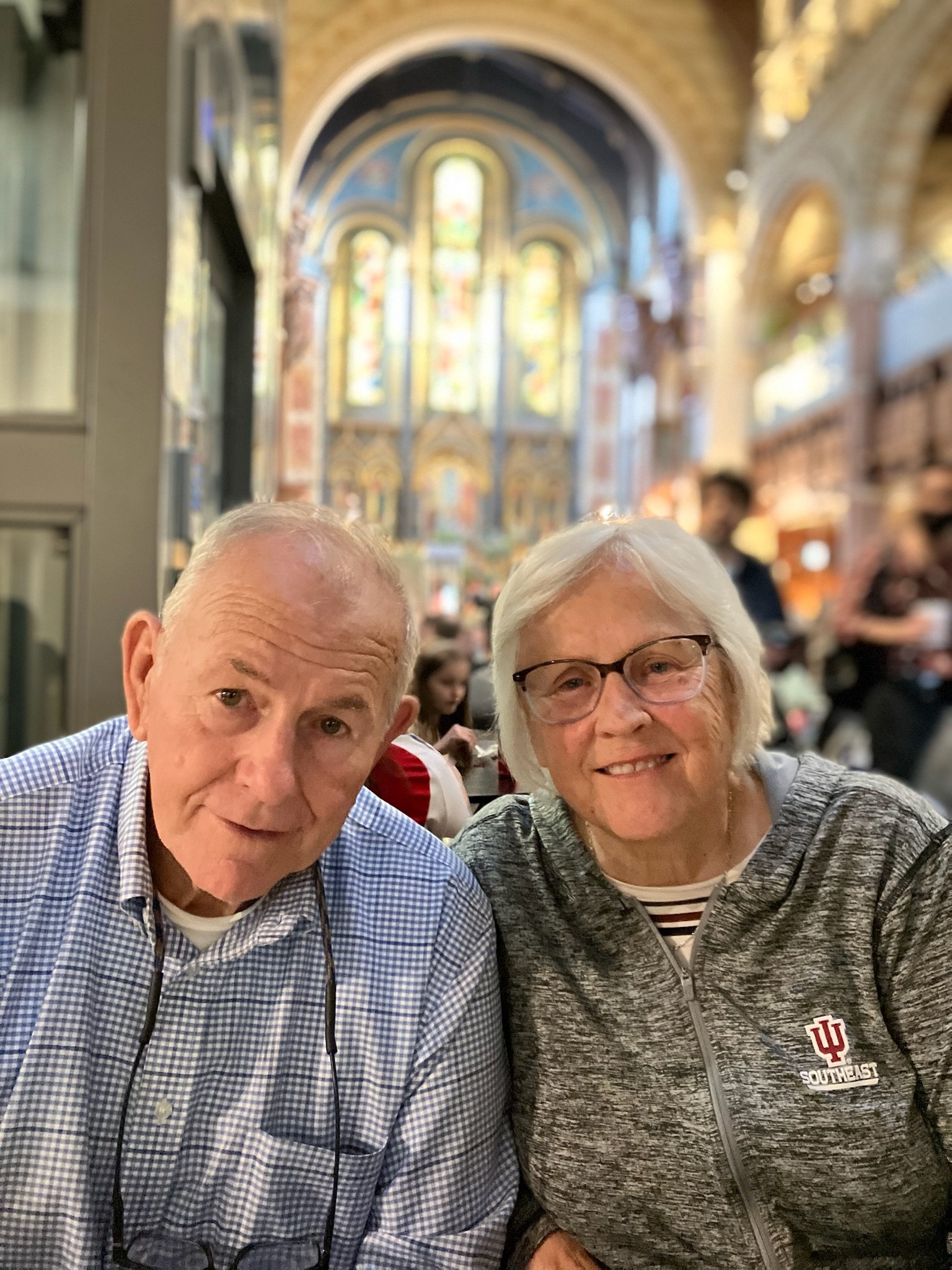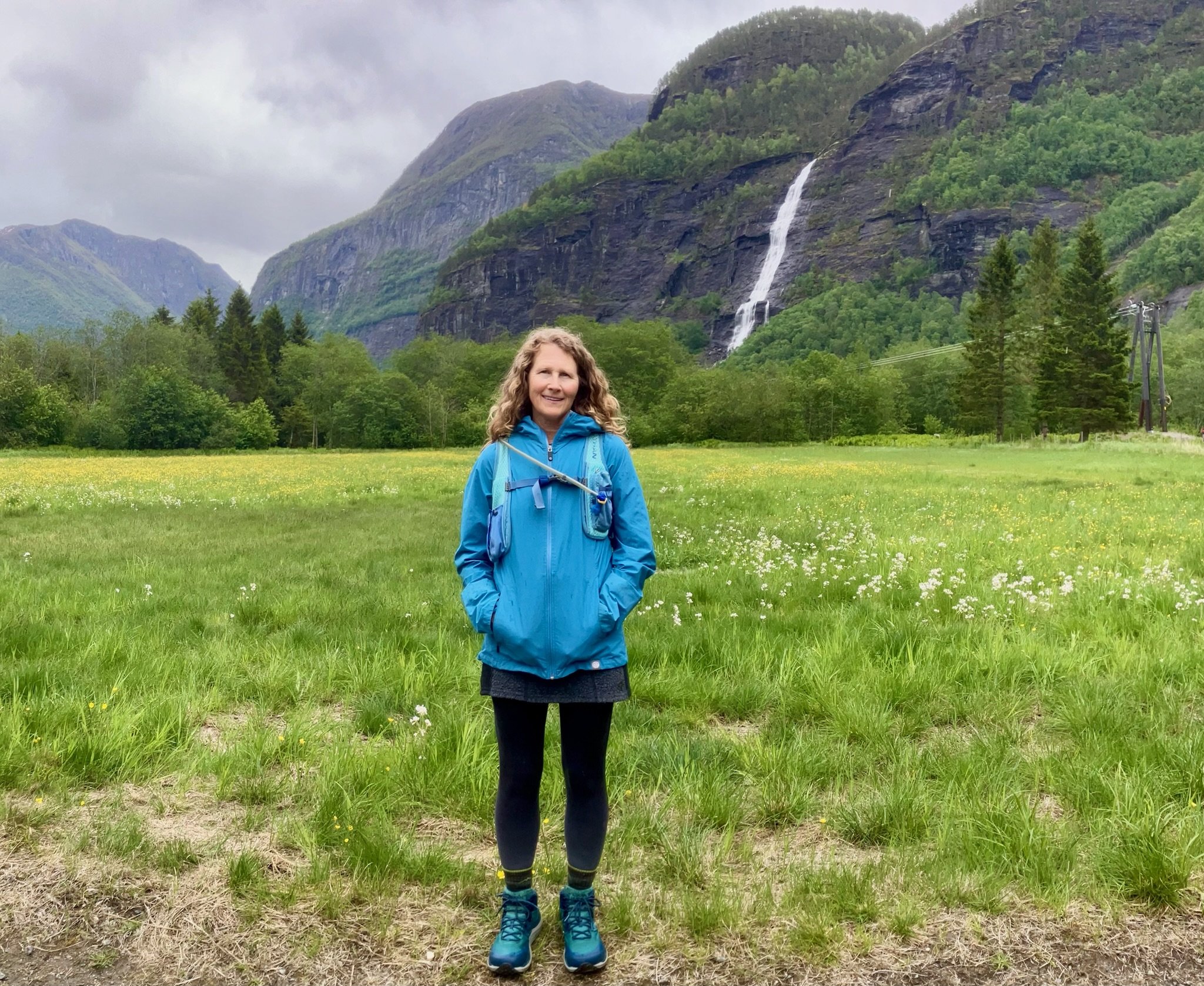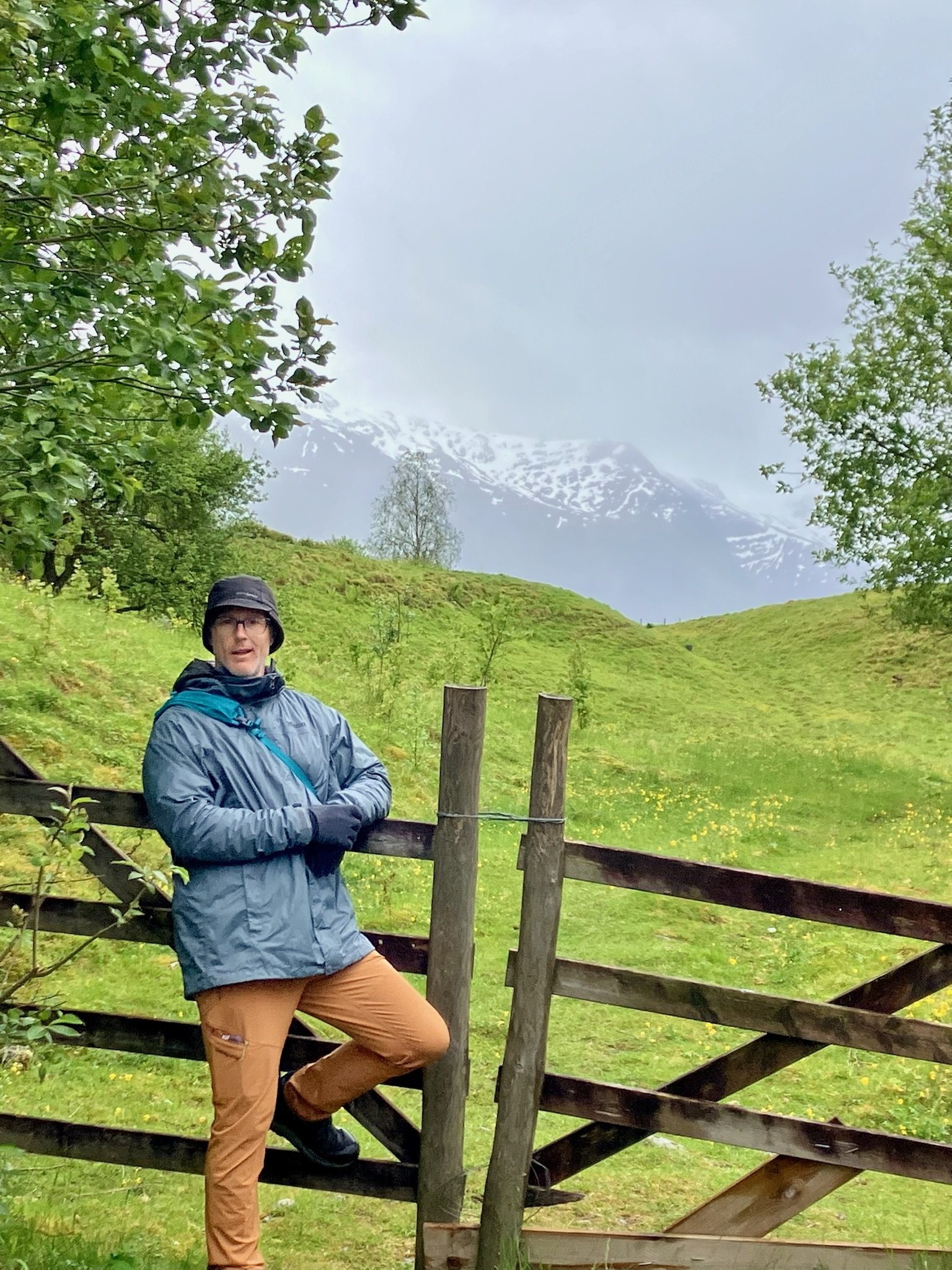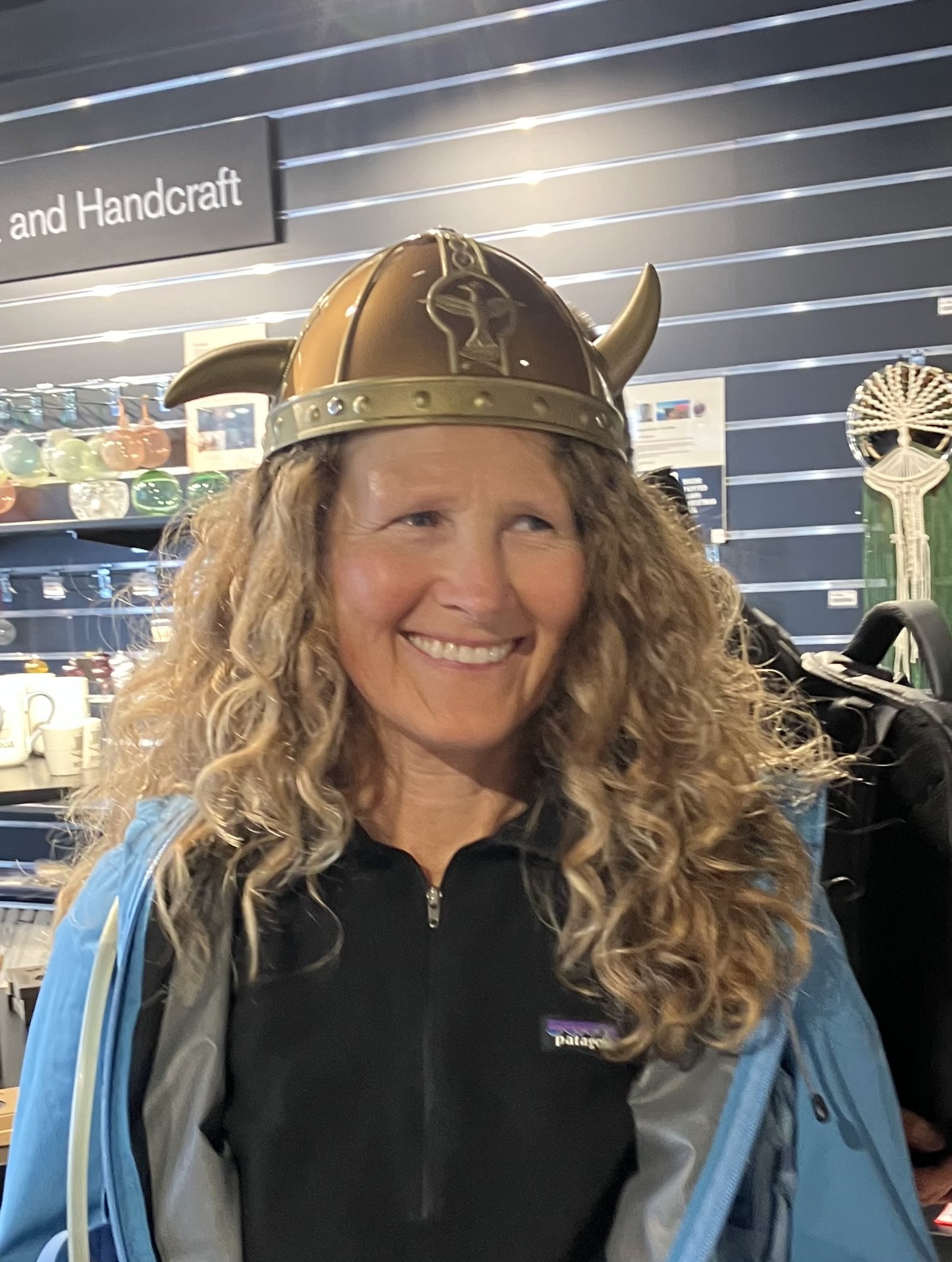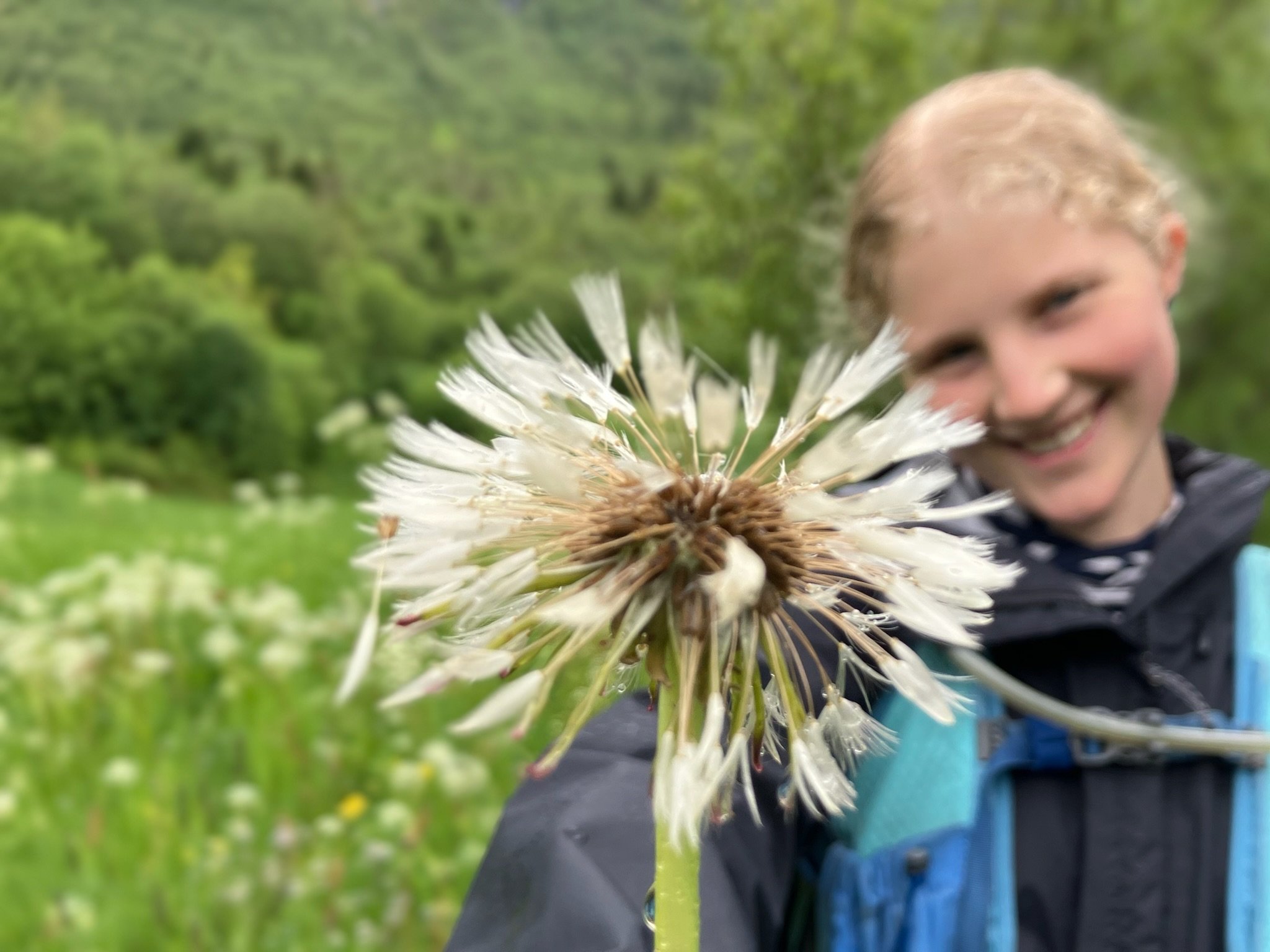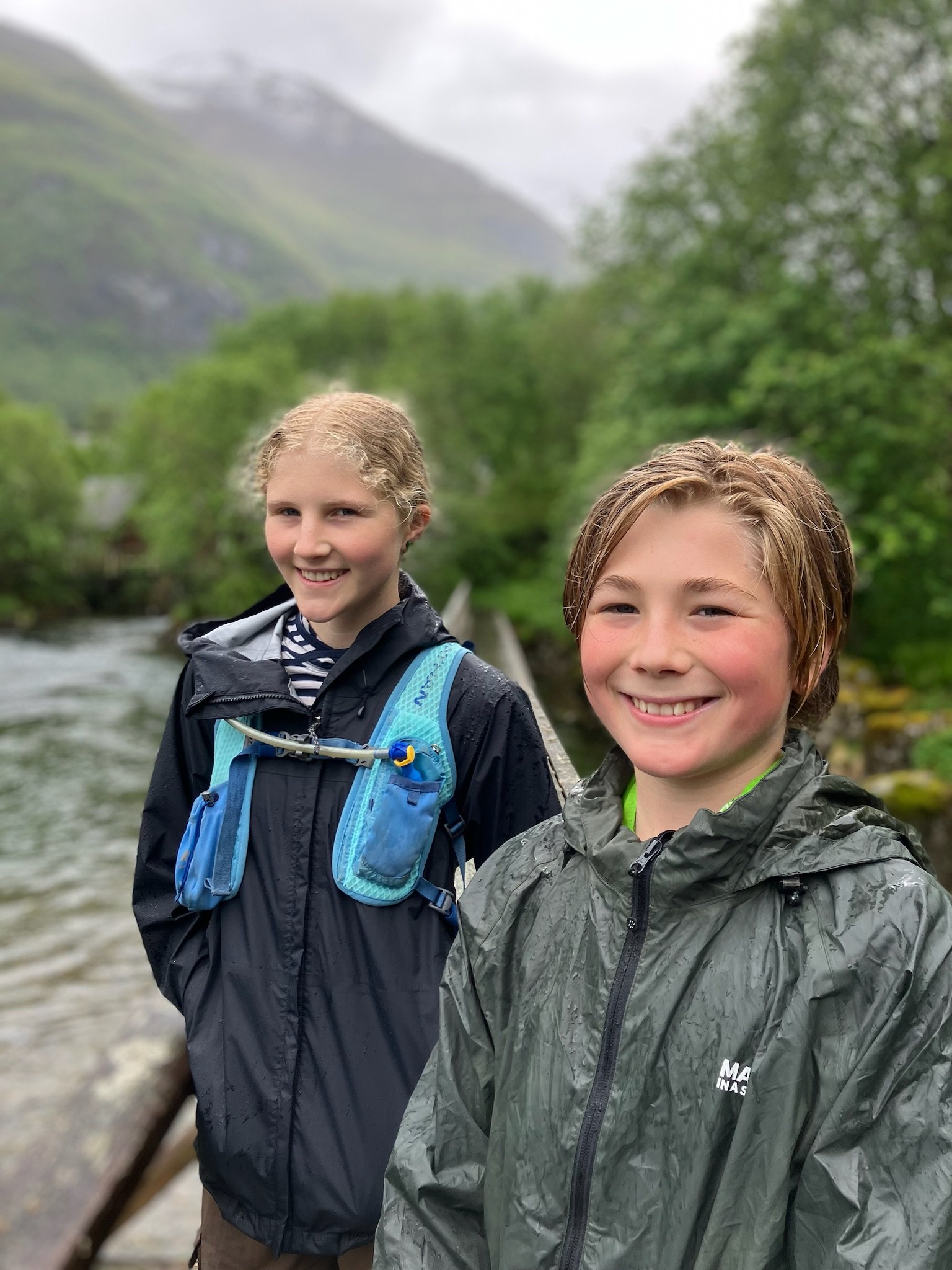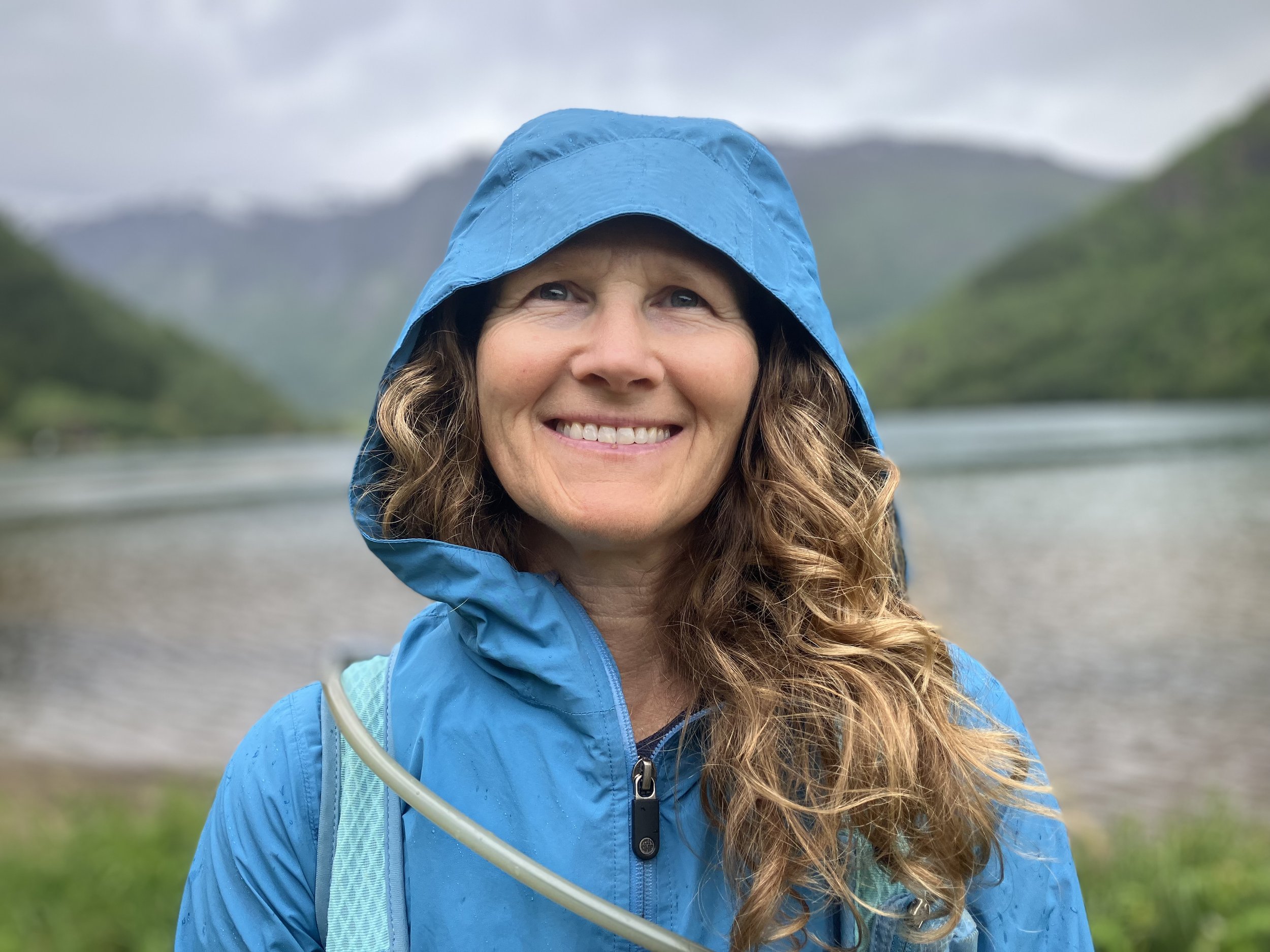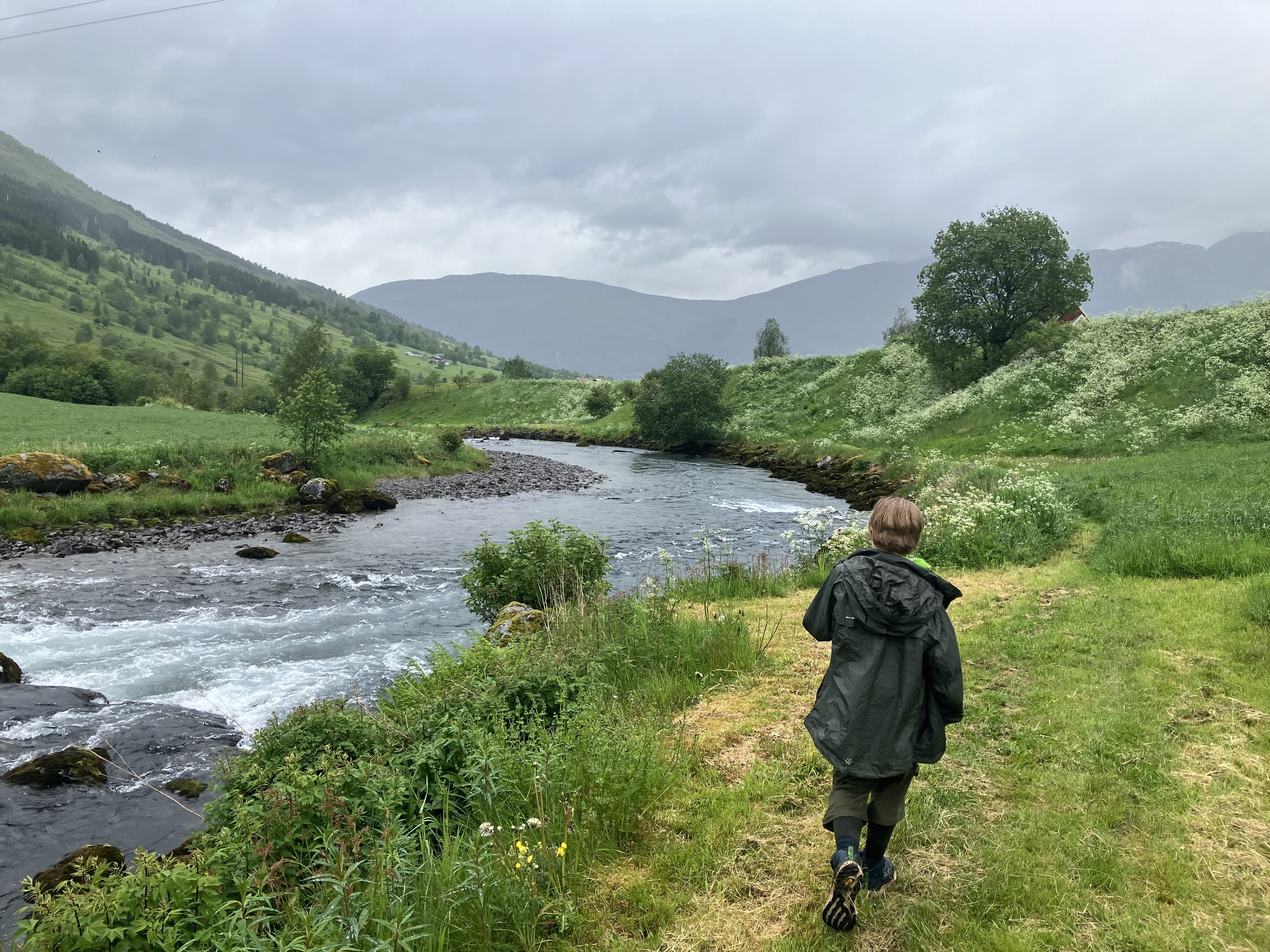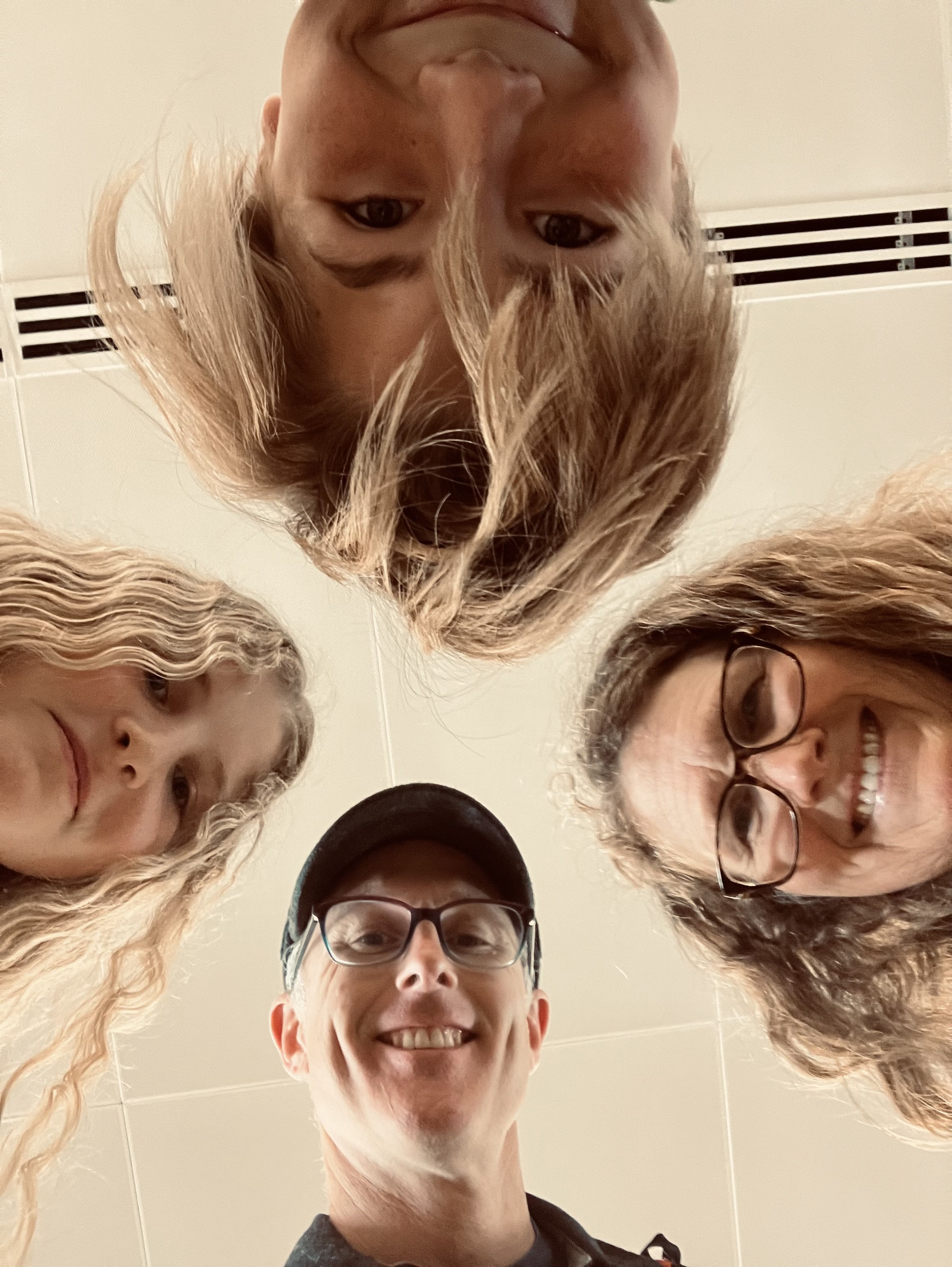Riding on a Donkey
“You have recently encountered—or are now living through—a fracture. Something once meaningful has become unfamiliar, maybe even alien. And yet, this rupture is not an ending but a beginning.You stand now at the edge of unknowing. The map you followed has dissolved. But you are free—utterly, terrifyingly free. Let go of the desire to make perfect sense of the past. Step forward. The future you’re called to does not demand certainty—only curiosity, humility, and faith that even lost meanings can become compost for something deeper. The words you once relied on might no longer hold. But that’s not failure. It’s the birth of a new language. Let yourself be changed by the journey ahead. Even if it begins in silence.”
the beginning of the West Highland Way, Milngavie, Scotland
The ability to create a shared narrative about life is a uniquely human trait and is often the root of family and social bonds. Fanny and I are both highly skeptical scientists who paradoxically enjoy fortune telling, divination systems like tarot and runes, and generally trying to ferret out meaning from life’s strange twists of fate. Causation and coincidence are both ways that events can be related. We tend to dismiss coincidence because of its unreliability, but contemplating non-causal relationships can often lead to insights that logic cannot. On this 3 week trip to Scotland and Norway we ended up with repeated references to Ludvig Wittgenstein, the Austrian philosopher, an old pop song, “Somebody That I Used to Know”, and the Tarot card known as “The Fool”. Using Chatgpt as a friendly oracle, we asked it to synthesize a meaning of these three themes and got the reading above.
Recently we have moved out of the house we’ve lived in for 12 years, my aunt Lois, that we have lived with for 9 years, has moved to assisted living, Fanny is closing her psychiatry practice, and we are baffled and curious about the future when the present is changing so fast. We planned this trip before any of these changes occurred and we were eager to see what some time away would do for our perspective on the future.
Part 1: Scotland, the West Highland Way Trail
the Jude abides
Having grown up in Kentucky and spent the last 12 years in North Carolina, the Appalachians have formed the backdrop for most of my life. Like all long relationships, I find myself deeply attached but struggling with gratitude. I have hiked and biked thousands of miles in these forests over the years, seen the miracles born of its unique biodiversity and felt depair at the destruction that the wildfires and hurricanes have wrought in recent years.
Glencoe, Scotland
Last year we drove to Nova Scotia (New Scotland) and saw where the Appalachian range terminated in the Atlantic Ocean. Before the last supercontinent, Pangea, separated into the continent that we know today, the Appalachians continued across what is now northern Scotland and are know there as the Scottish Highlands. Ironically, we planned this trip as an exotic vacation somewhere out of the Appalachians before realizing we were just picking them up where we had left off last summer.
We decided to see if we could walk the West Highland Way, a 96 mile trail that heads northwest from Glasgow and ends in Fort Williams. My parents had invited us to join them on a cruise up Norway’s coast along the fjords this summer and we wanted to be tired enough to enjoy cruise boat life. “Hiking to the hot tub and buffet” eventually became a bit of a mantra for me on the last few days of the trail.
After being inspired by some friends who took a family walking vacation last year, we decided to hike inn-to-inn. There is a small industry built up around the trail and the quaint isolated towns along the route. We used an agency to organize the trip. This was our first experience with outsourcing organization and planning, but with a goal of being able to just focus on the walk, we found it worthwhile.
We planned the trip last winter and expected to have a lot of time to hike as a family in preparation, but between hurricane Hellene, moving out of our house, and a bitter cold snap this winter, we really didn’t end up hiking as much as I’d hoped, and I had concerns that we had bitten off more than we could chew. Stella and Jude are 16 and 12 respectively, and Fanny and I are middle aged enough to require more bodily maintenance than we used to. I was sure that hiking 100 miles in a week as a family would be a challenge for each of us. But, with having two independent-minded teens and with feeling the vague ennui that plagues middle age, we hoped that facing a challenge as a family would help us get some perspective on what the future holds for us. Stella heads to college next year, Fanny is winding down her private practice, I’m changing jobs after I take a break next year, and Jude will be turning 13 which could mean absolutely anything for a good looking guy with truly fabulous hair and a gift for talking to senior citizens.
super-sized charm with a side of bandana
We spent a lot of time talking about what to take on this trip. We expected cool wet weather and midges, tiny biting gnats that swarm by the hundreds. We knew we’d be averaging about 15 miles a day but would only be taking day packs. We each had one larger bag that was transported ahead of us to each night’s lodging. But, during the day, we would often be far way from civilization in a variety of terrain with the possibility of any type of weather. We had picked the last 2 weeks of May in hope of arriving after the rain but before the bugs. But we also know the Appalachians; weather reports are as useful as horoscopes here. (Jogging in July? Maybe some brief unexpected hail) Truthfully, I do think it was the amount of time we have spent outside in western North Carolina that ultimately helped us more than “training”. Being comfortable in nature for long periods of time and being comfortable with one another were the sanity-preserving skills we relied on more than having a specific pace, a heart rate goal, or the perfect gear.
As we were packing the day before the trip, I saw Fanny place her large rechargeable vibrating foam roller in her bag and realized that, once again, I would be in charge of figuring our how to get an overweight bag checked without paying extra. (I’m not paying extra for overweight baggage until the airlines start weighing the passengers) My usual trick is to start talking to the gate agent while placing one of the smaller bags directly in front of, but not on, the scale. While continuing some inane patter, I put the overweight bag on the scale while partially resting on the bag in front of the scale. As it turns out, Fanny’s commitment to physical therapy and my zeal for dodging pointless rules worked out well for the whole family. Family-style foot rollering became a vital tool for keeping us trail ready, probably much to the annoyance of our downstairs neighbors who wondered why their ceiling was vibrating.
Both of our kids are voracious readers and on a vacation last year we found that Stella had packed one suitcase mostly full of books. So this year, my end-of-homeschool present was a Kindle for each kid, and this kept them pretty occupied on the long flight and longer layover in London on our way to Glasgow. Going through an airport always makes me feel like a marble on one of the marble-run toys that my kids had when they were younger, zig-zagging through security, riding down escalators and up elevators, and popping out in odd places with our kinetic energy totally spent.
We only had one night in Glasgow and were all trapped in the circadian hell that is overnight eastward travel. We ate dinner and walked around the university and its ancient castle-like buildings but my memory of the night is poor. According to my journal we ate cod cheeks and involved a friendly waiter in a family dispute about whether tennis balls are yellow or green. Our hotel room inexplicably had five small beds and I fell asleep while packing for the next morning.
I awoke with some anxiety about beginning the hike, but I have come to think that anxiety is appropriate before an adventure as long as I don’t let it make me irritable. We struggled a bit getting a cab to the trailhead but I really enjoy the way the cabs have the rear seats facing one another like some kind of urban gondola. We made it out of the city to the town of Milngavie and handed off our luggage to the transport service that would move them along to the next town.
After a “full Scottish breakfast” of haggis, black pudding, stewed tomatoes, baked beans, and toast, we found the trailhead, took a photo and began the trail. I never know what expression to make for the “before” photo of an adventure. It makes me realize that I have no way to guess what my future self will think about this moment after having experiences that I have not yet had. But, we were all excited to begin after so much planning and being confined to the small hectic spaces that international travel requires. A real goal of this trip was to have a vacation as temporally spacious as possible. So often, vacations turn into just trying to get to the next place. The idea of constantly arriving without planning was very appealing. Honoring the idea that the journey was was the destination felt like a new paradigm in vacationing, and one I will remain committed to.
Both at the beginning of the trail and throughout its length, I was amazed at the ease at which we were able to walk out of, and into, towns without ever having to cross a road. We have travelled the US extensively by van; I think we are up to12 or so trips back and forth or up and down the United States. Over the years we have realized that there is actually one country slowly being devoured by another. There is the United States that existed before interstates. I first encountered it while biking across the country in my 20s. It has unique and engaging small towns with thriving centers that are designed for pedestrians. And then there is the relentlessly homogenous fungal growth that Fanny and I call “interstate city”. Everywhere near any interstate is an invasive and monotonous collection of franchises and their parking lots. Why anyone would travel across a country to inhabit the exact same surroundings they just left will always remain mysterious to me. We saw very little of this pathological approach to “growth” in Scotland.
As the remaining traces of the city dwindled, the trail began to slowly wander up a wooded ridge and we met our first highland cattle. Unfortunately, they seemed susceptible to the influence of social media and each cow had the same haircut that we also saw on every male between the ages of 18 and 22, looking as if they were wearing a toupee that had slid forward due to a sudden stop.
highland cattle
As we crested the ridge, the scenery changed dramatically, opening up into the treeless expansive mountains to the north. Due to a combination of human activity, predator loss, and the introduction of grazing species, most of the Scottish highland remains grass-covered up to the rocky spines of the mountains. This heavily contributes to the dramatic scenery. In North Carolina, hiking between mountains is like traveling through a green wormhole and exiting at various viewpoints. In Scotland, we were able to see where we were going and where we had been throughout most of the day, which was generally stunning but occasionally disheartening.
We took a brief detour to a distillery to have lunch and sample some scotch. Having grown up in Kentucky, I think I will always prefer the tase of bourbon, but being surrounded by people with Scottish accents more than makes up for the difference. If I could have brought home a Scottish accent as a souvenir instead of a bottle of scotch, I would have. We also encountered “honesty boxes” along the trail where there would be food and snacks for sale, with a cash box or Venmo QR code. These weren’t common enough to rely on but were exciting to encounter for the kids who required roughly 10,000 calories a day for this effort. I suspect their chewing muscles got as much exercise as their legs. We did bring a caffeinated “sports drink” powder that some bicycling friends recommended and I do think that small steady doses of glucose and stimulants helped keep everyones spirits up. Watching Jude with hiking poles on caffeine was a steady source of entertainment. Like a bizarre robotic metronome set slightly too fast for the song, he was usually far ahead of us, passing strangers who were startled to see a kid his age on the trail. Apparently very few kids do this trip according to locals that we spoke with. After around 14 miles we ended up in the tiny town of Drymen and ate dinner at Scotlands oldest pub (1734).
our after dinner entertainment
Over the next two days we made our way through the towns of Rowardennan and Ardlui along the eastern shore of Loch Lomond, Scotland’s largest loch. This took us through a national park on a busy Saturday. We managed to arrive at a rare dry and sunny stretch of weather for Scotland and seemingly the entire population of the country was aiming for the lakes. But, like all national parks, once we got a mile or two away from the nearest parking lot, the crowds thinned considerably and left us on a meandering rocky trail up and down the banks of Loch Lomond. Although not our longest day, the broken trail with its constant up and down made for some of the hardest hiking of the trip. In general , much of the trail is wide and well graded, but intermittently we encountered every type of terrain imaginable. We were able to find espresso and ice cream in the national park which is like getting 2 miles of hiking for free.
over looking Loch Lomond
Near Ardlui, we were hiking on the remote and inaccessible eastern shore of Loch Lomond, intermittently swimming and enjoying the abundant purple and blue wildflowers. Our directions for getting to our hotel stated, “When you see the large flagpole, raise the red buoy to the top and wait for the ferry.” After locating what looked like the world’s most remote tether-ball setup, we raised the buoy and waited. It was at this point I laid in the shade on the beach near the lake and experienced 15 minutes of what may have been the finest weather I’ve ever known. With warm sore muscles, I felt a light cool breeze in shifting shade and listened to the sound of gentle waves on the shore. I could hear the kids laughing and playing in the water and had only to wait for a boat to take me to food and beer. If it turns out that this was the best 15 minutes of my life, I’m okay with that.
summoning the ferry
While I have mixed feelings about alcohol in general, I had no interest in avoiding local cask conditioned beers that were unique to each town. Mercifully most of these beers are 3-4% alcohol making it possible to enjoy 2 or 3 amidst the scenic grandeur of sunset in the mountains. Each of the tiny hotels we stayed at also offered the option of a packed lunch, but these turned out to be a bit too Scottish for our tastes. Described as a cheese sandwich and a chocolate bar, we received an odd amalgam of pickled onions, American cheese, and butter on white bread accompanied by 2 Mars bars. Our kids are only vaguely familiar with candy bars but learned to appreciate their rejuvenating powers on a long hike. As long as we kept the kids well fueled, they lead the way, often singing a repetitive song about “riding on a donkey”, that will now be stuck in my head forever, and having the types of nonsensical sibling conversations that continue to mystify my only-child self. As far as I can tell, siblings, who genuinely enjoy one another, will dispassionately but meticulously argue some triviality as a means of passing time while not actually being remotely emotionally invested in the outcome of the conversation. In fact if the conversation leads to even greater inane and pointless discrepancies of opinion, this seems to be some kind of success. Maybe this is training for marriage? They also practiced their Spanish, talked about some weird math problems and, in a true homeschool breakthrough, Stella finally got Jude to remember the order of the months of the year. For a kid that can beat me at chess and do long division in his head, the months of the year have been an amusing gap in his education.
Tangent story: Jude has always been homeschooled and learned to read early and capably. Years later when he asked what a certain word meant, I told him to look it up in the dictionary. He got out the dictionary and flipped through it with increasing frustration. “How is this thing arranged?!?”, he asked. Despite teaching him the sounds that all the letters made, we had neglected to ever teach him about alphabetical order and he had to spend a week singing the alphabet song as a 10 year old.
not remotely foreboding
On our fourth day we reached Tyndrum, a slightly larger town that had grown in response to the number of hikers passing through. This was the hardest day for me. Over the last 50 miles, the bottoms of my feet had gotten fairly painful despite switching shoes and soaking my feet in the cold water of the lakes and creeks. It got hard to be present with the scenery or experiences, and my mind was dominated by alternatingly feeling sorry for myself and thinking of strategies to overcome it. I have an old friend who is dealing with cancer as bravely and gracefully as I have ever seen it done, and we have had some conversations about how even hardship can be celebrated when you feel like you have choices. This began to be the psychological salve I needed. Living life fully and taking risks requires dealing with pain and uncertainty, but having the choice to do so is a gift not to take for granted.
When we arranged the trip, scheduling meant that we needed to complete the hike in seven days. This gave us an average of 15 miles a day but, with the location of the towns, gave us one 10 mile day and one 19 mile day. Our family has never hiked 19 miles together before, and after the 10 mile mark that day, we would be too remote to bail. On each day of the hike we had the option of just traveling by van with our bags to the next night’s lodging, so we had to decide as a family if we were going to attempt the 19 mile hike the next day.
While I am generally the cheerleader for these types of adventures, my aching feet had me at least considering skipping the next day’s hike. We sat in our room all taking turns with the vibrating foam roller, applying various ointments, and eating the ubiquitous shortbread cookies that are a staple of Scottish inns. It was a unique moment in family life for me. We all had to be very honest and thoughtful about what we thought we could do and what we were worried about. Stella was clear that she wanted to try it, being almost 17 and mostly made of legs by weight. Jude, like me, was conflicted and also, like me, mostly interested in what everyone else thought. For me, Fanny had the most compelling standpoint. Having dealt with some health challenges and chronic knee injuries she said she had made it this far and wanted to push on. Often, as a father and someone who considers themself strong and athletic, I have felt like the one to encourage my family to try things. Finding myself relying on my entire family for a bit of courage and daring was a real gift. There was a subtle but profound reorientation of family life on this trip and I saw it most in this moment. I even find myself getting emotional writing about it. This journey gave everyone in our family a chance to contribute to overcoming a challenge. Moving from a parent-child hierarchy to more of a team approach feels good and appropriate at this point in our life.
Yesterday I was talking to an old friend about this trip and all the walking we did and he recounted a vacation that his family had taken to Disney world where they aimed to get the absolute most out of each day. (This is also my friend that I would vote most likely to be kicked out of Disney, oddly enough) They are an organized and clever family and ended up averaging around 14 miles a day of walking with a max of 22 miles one day. So, apparently families walking a lot for vacation is a thing that occurs in a lots of contexts.
Our day was just a little over 19 miles and, unexpectedly, turned out to be one of the most enjoyable days of the trip. We had a bit of cloud cover that lessened the sun exposure and a lot of the trail was on old abandoned gravel military roads. At the ten mile mark we came to an Inn, the only building around for miles, rested in the shade, and ate some lunch. I spent a bit of time sitting in a creek near an old stone bridge eating an apple (literally cooling my heels). I found in that moment an elusive feeling that is at the heart of my desire to travel. I felt fully present in that place and at peace with myself, my family, and at not knowing what to expect over the next mountain. I once read about a study where people attended an event and some were allowed to take pictures and other were not. The group that did not take pictures had better recall of the details of the event. In moments where I feel truly present, sometimes I have the impulse to take a picture to remind myself of the feeling later. Sometimes, I end up just trying to take some time to focus on the the details of each of my senses; the smell of the breeze over the cool water, the taste of a tart apple, the pins and needles of the cold water on my feet, and the sound of the creek both behind and in front of me. In doing this I hope to create a place in my memory that I can really return to that doesn’t require a phone.
snacks ‘n ruins
So… baby sheep. Omnipresent in Scotland and cute as heck. The local farmers even have to put signs up asking hikers not to pick up the baby sheep because it is surprisingly tempting. But, and I wish I had video documenting this, baby sheep are also slightly terrifying. While we were oohing and ahhing over these little animated cardigans, we saw several baby sheep find their mothers for nursing and we were startled by how they vigorously and repeatedly headbutt their mother’s udders to start this process. It looks like a boxer training for a fight on a speedbag. We began to notice a pattern of hearing an adorable baby sheep bleating and then seeing a mother start trying to sneak off over a hill before she got the milk relentlessly beaten out of her.
This long day also brought us into the largest mountains of the trip with sweeping overlooks and, often, a complete absence of human structures in our surroundings. It felt vast and remote and I was glad for the other hikers on the trail at times. We ended at the remote Clachaig Inn set in the beautiful valley of Glencoe. The clerk accidentally gave us the key to the wrong room which somehow lead them to later think that we had smuggled in extra children and got us a brief Scottish scolding until it got sorted out. It partly hinged on them not believing that our kids were actually dong this trail. It seemed like a good trip for kids to us, but we didn’t see any other kids or teens and most everyone was surprised to see ours. And with our habit of walking fast but taking lots of breaks, people got to see our weird, singing, caffeinated, pole-walking kids repeatedly throughout the day whether they wanted to or not.
At this point we had completed about 75 of the 100 miles and had one steep 10 mile day and one mostly downhill 15 mile day ahead of us. My feet had improved thanks to Fanny’s various liniments and physical therapy paraphernalia but we were all beginning to feel the miles adding up.
The 10 mile day started hard. We ended up stuck in a line of slower hikers going up a steep narrow trail with biting midges and hot humid weather. But at, and after the summit, it was casual and beautiful and ended at a cute pub where an elderly man won a giant jackpot at a slot machine in the corner as we walked in.
It’s hard to recreate this in writing, but I want to try at least for the sake of not forgetting it. Fanny, when hungry, sometimes get a little loopy and we have all learned to throw some calories in her when we hear here talking a little slow or just staring at something. Again, it takes teamwork. While sitting around a table in the pub, we were looking at maps for the next day and doing some planning for what to take and how much food we would need. At one point I said to the kids, “Looking at this elevation profile, I can imagine this part being kind of sneaky hard.” After a pause, Fanny looked at us, slowly and earnestly nodded, and said “shaneeky hurd,” in uncomprehending agreement. The kids and I looked at each other and got her bag of potato chips, but “shaneeky hurd” became a new description of possible trail conditions. She denies any memory of this whatsoever.
Our last day began with a long slow climb out of a wide valley with Ben Nevis, Scotland’s tallest peak, fading to our rear. Dry-laid stone fences, ancient ruins, and ubiquitous udder-boxing baby sheep filled the landscape. At the summit we were able to see the countours of the valley that would lead to the end of our journey in the larger town of Fort Williams. The West Highland Way trail is uniquely scenic and is a well-made and varied trail. The last few miles, however, are steep gravel roads and pavement. We were able to find a small foot path along the river leading into Fort Williams that saved us some time on roads. The marker for the end of the trail is downtown amidst a row of shops and restaurants and we stopped for a photo. Our bed and breakfast was a half mile further and was one of the longest half miles of the trip. The way that every hotel or lodging has shortbread cookies in the room really works though; just enough energy to power through showering and preparing for the walk back to town for dinner.
At dinner, we celebrated ourselves and our family and relived some of the struggles and surprises of the walk. I was sad for it to end but also realized that I had been apprehensive about attempting it for so long that I also felt some relief. We all agreed that waking inn-to-inn made for a different type of adventure and was a nice change from backpacking or van camping. We also all agreed that shorter hikes would have left us more energy to engage with the places we stopped for the night and that it would have been nice to have built in a rest day somewhere. In the sense that some adventures are big enough to offer you a division between the past and the future, this hike served us well. Although the vacation was only half over, I could see the possibility of returning home with some new thoughts in my head and some idea of my priorities for the future.
end of the trail marker in Fort Williams, Scotland, 100 miles later
Part 2: Norway, southwestern coast by cruise boat
Between the two camper vans we have owned, we have racked up almost half a million miles of van life at this point. We were hanging out in vans before instagram existed and so, for a long time, we didn’t even have to wear yoga pants and photograph the sunset from the roof every night. I have often thought of our van as a tiny train on the freeways, especially when I’m sitting in the back and watching the landscape unfold, or if we are in Florida, seeing exactly how shameless lawyers are willing to be on billboards. But Europe has actual passenger trains and no lawyer billboards so were able to travel from Fort Williams, Scotland, to London while sitting around a table, reading books, playing games, and strolling back and forth to the snack stand. There was a moment of panic where we realized that we very quickly had to change train stations and not just trains in Glasgow. These are the kind of moments that can really test a family, but I think our week of hiking had fused us into a highly capable, but suitcase laden, amoeba of action. We filled a cab so full of hiking gear that we couldn’t actually see one another and fought our way through the thick Scottish accents to an understanding of where the next train actually was just in time for it to depart.
enjoying not walking
My parents have now taken us on 4 cruises, and thanks to them, my kids have seen a lot more of the world and eaten at a lot more buffets than I ever had at their age. Prior to being on a cruise boat, I had looked down my nose at them a bit as a way to travel. There are still times where I feel like I’ve been trapped in a hotel, but like the inn-to-inn approach to hiking the West Highland Way, a cruise boat does give you the opportunity to forgo thinking about logistics and focus on being in a place. Having a room that travels along with you makes things very easy. And, well, the buffet is pretty fantastic.
my parents, London
fjords!
Seeing the fjords of Norway has always been a dream of mine, ever since reading “The Hitchhiker’s Guide to the Galaxy.” If the reference is lost on you, breathe a sigh of relief that you are not a total dork. And being on a cruise boat may have been the best possible way to see the fjords I could imagine, at least in the absence of owning a private yacht piloted by acrobats and poets.
A fjord is an oceanic inlet, longer than it is wide, carved by a glacier and typically characterized by very steep sides. In western North Carolina, we live in a waterfall Mecca. For my last birthday, I received a map of the waterfalls within 2 hours of us and there were over 200 of them. Nonetheless, in the 4 days we spent traveling in and out of the fjords in Norway, I saw the 100 tallest waterfalls I’ve seen in my life. Often cascading thousands of feet from the top of the fjords to the water below, splitting and rejoining or disappearing and reemerging unexpectedly, there were waterfalls on all sides. From the top of the cruise boat, hiding neck deep in a hot tub with a warm hat on, we watched the waterfalls slowly parade by and saw impossibly remote farms and occasional rainbows.
At the head of one fjord, we docked in the town of Skjolden. You have to be careful with Scandinavian names; their penchant for placing incompatible consonants together can lead to some wicked tongue injuries if you just start reading aloud without warming up first. In Skjolden, Fanny and I let the kids stay on the boat with the grandparents and enjoy the hedonist pursuits that appeal to either extremity of age. As middle aged people, we were forced to earn our enjoyment through hardship, and decided to hike up the river that fed the fjord between the steep valley walls. We also took a side hike up to Ludwig Wittgensteins cabin where he spent two years in seclusion writing “Tractacus Logicus Philosophicus”, his most well-known work.
In my 30s, I fell down the rabbit hole of western philosophy and finally wound up at Wittgenstein who argued that language was an insufficient tool to describe the nature of experience. “What cannot be spoken of clearly, must be passed over in silence,” he said. This sort of led me into eastern philosophy were I ended up at Lao Tzu’s Taoist saying, “The Tao that can be spoken is not the real Tao.” At this point, seeing philosophers from opposite hemispheres, separated by 3000 years of time, agree that talking about the meaning of life was a waste of time, I gave up on philosophy altogether. I began to see why shared experiences have so much meaning. When you have stood next to someone and seen something truly unique, beautiful, frightening, or inexplicable, you can later use words to remind one another of the experience, but that indescribable shared experience transcends words and momentarily penetrates the solitude that characterizes so much of our lives.
the view from Wittgenstein’s cabin
Also in Skjolden, I was able to buy some toothpaste so I could quit borrowing Stella’s every night. It was labeled “Frisk Pust” and I now think that foreign toothpaste is a really under appreciated genre of souvenir. Twice a day, while frisk-pusting, I think about our amazing vacation.
As we wound our way out of the valley, back through town, and to the dock, it began to rain and everyone wanted to get back on the cruise boat at the same time, creating a long line for the two gangways. Being a cruise boat, and devoted to the myth that discomfort is evil, they had cruise boat staff passing out hot chocolate and umbrellas like we were desperate refugees who had just survived a hurricane. To Fanny’s and my increasing amusement however, the line to enter the cruise boat wound along the edge of a sheep farm and and the steady bleating of lambs seemed like it was coming from the poor lost souls in line, causing us to giggle.
The following evening and morning we made our way back to the North Sea with its cerulean waters and ubiquitous windmills and navigated another long fjord to the town of Olden, where we hiked 9 miles along a glacial lake with the kids. Stella, who grew up playing in the cold waters of the Pacific coast of Oregon, has a lifelong love of swimming in cold water. She has swam in the Bay of Fundy, Loch Lomond, and now a glacial river in Norway. Every teenager is weird, but I increasingly enjoy her particular flavor of strange. While she was swimming, Jude and I headed back to town on our own to look at some Viking themed souvenirs.
On the boat we enjoyed going to dinners and shows with my parents as well as playing board games and card games. My family has always enjoyed playing games and I think the tiny victories and losses of games can be a pressure release for the inevitable stresses of family life. But any time spent with 3 generations sharing an experience always thrills me. That night we were talking about various entertainment options on the boat and Jude said he wanted to go to the casino. My father, who is skeptical at baseline and practical to a fault, looked at him and said, “Why would you want to go to a casino?!?” Jude, despite being 12, managed a steely-eyed stare out the window and said levelly, “Tonight… I feel lucky.” I’m still not sure if he meant that but I’m not gonna tell him that they sell lottery tickets at gas stations just in case.
Olden, Norway
Our last stop on the cruise was in the town of Stavanger, Norway’s third largest city, founded in 1125. It shocked me that Norway has been a country for nearly a thousand years despite some shifting of borders and an intermittently contentious relationship with the rest of Scandinavia. Norway’s government owns the bulk of the oil fields in the North Sea and also its rapidly expanding wind power. Without exaggeration, we frequently saw thousands of wind turbines from the ship. This means that Norway’s government is well funded and, consequentially, so is its education, healthcare, and social security system. Although the coastal climate is moderated by ocean currents, the remoteness and extremes of weather have historically kept the population density low. We spent most of our time in the wilderness when possible, but in the urban centers we experienced a no-nonsense kind of friendliness. The charming use of “Hei-hei” as a greeting always made me smile. The lack of public advertising and the emphasis on pedestrian friendly planning were remarkably refreshing. So often my view of America is limited to looking out a car window at fat people and ads for food and soda. When you design a space that can only be navigated by cars and you emphasize consumption as your only economic strategy, it’s not a surprise that there’s a market for diabetes and depression medications.
With the larger size of Stavanger, we would have had to travel by bus to get to any longer hikes, so we spent the day exploring the city. Despite my kids being 17 and 12 (Stella was 16 when I started writing this and just turned 17) they still have a shared and somewhat kooky enthusiasm for playgrounds. In Stavanger, they got their fill of swinging, spinning, bouncing, and staggering-around-while-dizzy as we walked through the city parks. We also wandered through a large cemetery where each grave had its own landscaping and there were watering stations and watering cans for public use. Being in a public place where even the dead were shown respect and there was no litter or vandalism gave me pause as I considered how much our culture has changed in just my relatively short time as an adult in America.
Stavanger also has a large museum devoted to the oil industry, with a playground made from discarded industrial equipment where kids can crawl through massive pipeline pumps, bounce on discarded ocean buoys, and climb on discarded oil rig girders. Clearly, Norway must have mandatory tetanus vaccines. We wandered through the historic waterfront with brightly colored wooden buildings from the 1600s. We saw quite a bit of well done graffiti walking through the city, which is also know for its murals. Again, Norways tendency for tidiness was evident, as much of the graffiti also had elaborate faux frames spray painted around it, making some of the pedestrian underpasses (yes, tunnels that allow pedestrians and bikers to safely cross large highways) seem like small museums.
oil museum park
Back aboard the boat, we had a day on the North Sea as we made our way back to England. Recently, Fanny commented that nostalgia may be one the largest unrecognized barriers to happiness, but I still find it a weirdly common place for my mind to end up. My version is slightly different than some though. I often experience nostalgia for the present moment. It can strike me out of the blue. Recently, Stella was bouncing around shaking her head after cutting 12 inches of hair off, and I experienced it acutely. It's that realization that, when it’s all over, it’s these little moments that I would most choose to return to and visit just one more time. On the North Sea, thinking about the adventures of the past several weeks, sitting at a table with my parents and children, and watching time inevitably unwind into the future, I felt joy and gratitude of this moment and I felt a great desire to slow time down just a little. When you are young, the future and its myriad possibilities beckons like an unknown city on the horizon. When you are old, I imagine, your memories offer you the knowledge of what truly mattered. Middle age, despite its vagaries, offers a nice mix of the two; alluring uncertainties ahead, but treasured memories behind.
As I sit at home and read through my journals and sort through the pictures, discarding the ones where I’m just too distractingly handsome, I feel changed by this trip which is not always the case after a vacation. Sometimes vacations are just a respite from the storm of modern life. But this trip seems to have created meaningful changes in my mind and heart. I have a new view of my family and what we are capable of when we rely on one another. I have an increasing confidence that the large and impulsive decisions we have been making since hurricane Hellene may be a trajectory instead of just careening off the guardrails like we sometimes do. I find myself returning to the quirky and random fortune generated by feeding Chatgpt some coincidences and oddities of the trip and feeling an increasing comfort with not knowing what the future holds. The part about silence, though…that’s not really very likely for me.
“You have recently encountered—or are now living through—a fracture. Something once meaningful has become unfamiliar, maybe even alien. And yet, this rupture is not an ending but a beginning.You stand now at the edge of unknowing. The map you followed has dissolved. But you are free—utterly, terrifyingly free. Let go of the desire to make perfect sense of the past. Step forward. The future you’re called to does not demand certainty—only curiosity, humility, and faith that even lost meanings can become compost for something deeper. The words you once relied on might no longer hold. But that’s not failure. It’s the birth of a new language. Let yourself be changed by the journey ahead. Even if it begins in silence.”
three hairs and a hat



